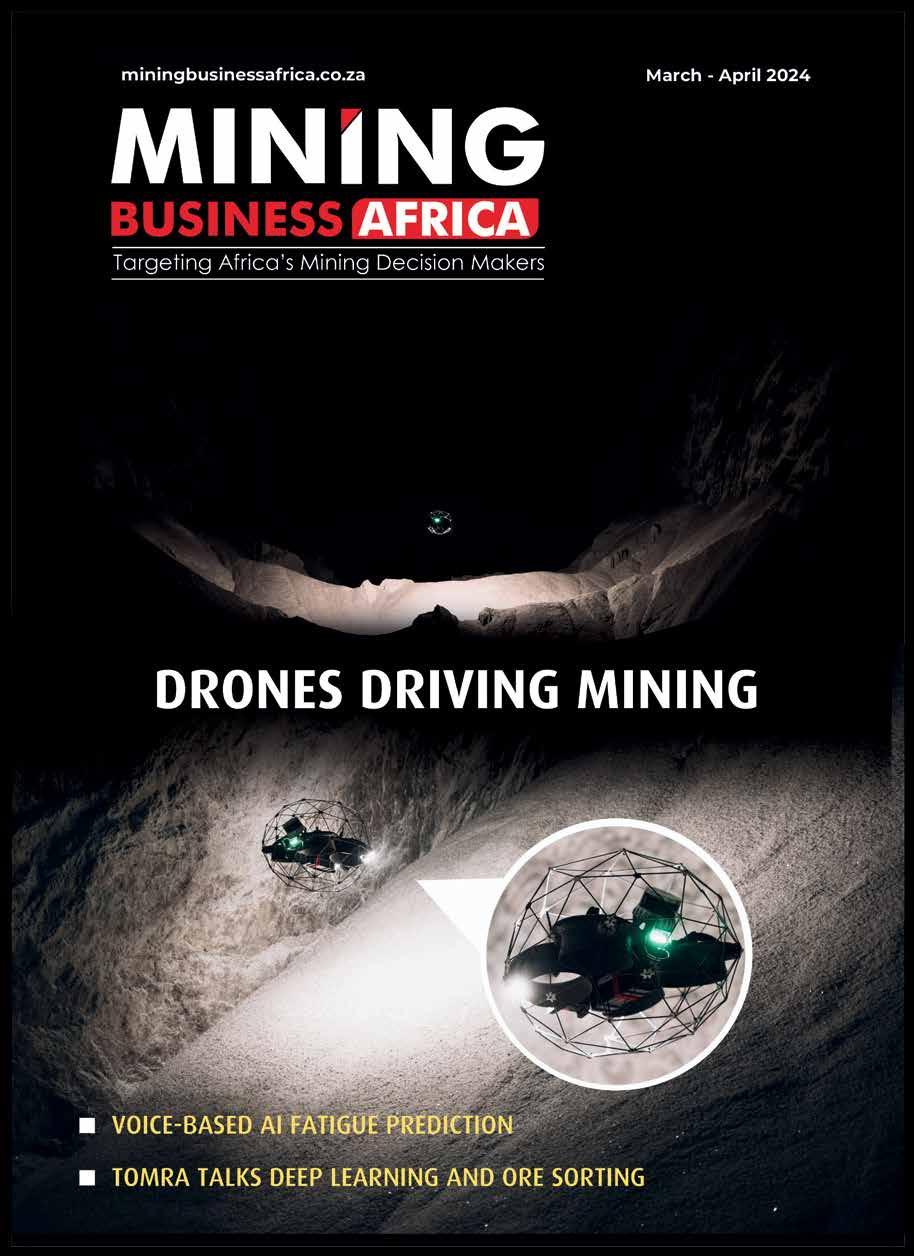
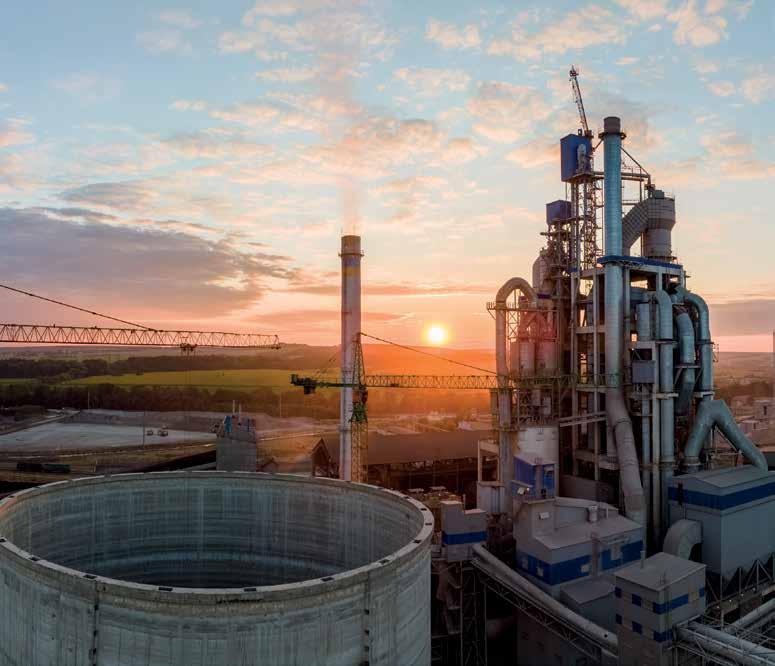
Munters (Pty) Ltd 22 Angus Crescent - Longmeadow Business Estate, Johannesburg, Gauteng 1610 South Africa Tel dir: +27 11 997 2000, Mobile: +27836333764

Cover Image:


For all the hype, GPS-enabled drones cannot operate in some nooks and crannies of underground mining. This is where the Elios 3, produced by Swiss drone company Flyability, fills the gap. Equipped with the high-resolution Ouster OS0128 Rev 7 LiDAR sensor, in combination with the world’s leading FARO Connect SLAM algorithm, Elios 3 creates incredibly accurate 3D maps


Susan M.
susanm@miningbusinessafrica.co.za
Sales and Marketing
Winnie Sentabire
winnie@miningbusinessafrica.co.za
+27
Chantelle C.
Writers
chantellec@miningbusinessafrica.co.za
+ 27 10 055 3356

Mining companies are waiting for the results of General Elections in Africa’s most advanced economy with bated
In the past few weeks, I chatted with a few decision-makers of companies involved in the South African mining supply chain on the sidelines of a high-profile event. The general impression I got was that everybody is waiting for the results of the most critical elections in the 30-year old democracy, scheduled for the 29th of May 2024.
It seems the corporate heads don’t mind how the results will pan out, heads or tails. But specifically, how this will impact their long-term investment plans.
Naturally, executives are worried about the effect of the post-election political risk on their investment. Already, there have been lingering reservations about the uncertainty of mining policy. Coming to the fore is the speed of issuing relevant operating licences and contentious labour laws.
To a large degree, this should be understandable.
A lot has been trumpeted about the massive economic potential that lies unearthed in South Africa’s mining sector. But the potential is not the real thing. Action is needed to turn that into tangible gains for the benefit of every South African citizen.
Hopefully, whichever party or coalition will come to power will have the interests of South Africa’s mining industry at heart. It’s South Africa’s eleventh hour, and decisive action is vital.


30
02 CONTENTS March - April 2024 Media Icon (Pty) Ltd makes every effort to ensure the accuracy of the contents of its publications, but no warranty is made as to such accuracy and no responsibility will be borne by the publisher for the consequences of actions based on information so published. Further, opinions expressed are not necessarily shared by Media Icon (Pty) Ltd. Location: Max Offices Sandton, 145 Second St., Parkmore Gauteng 2196, South Africa www.miningbusinessafrica.co.za
42
Africa’s Eleventh Hour
Editor’s Note Nick Barnes editor@miningbusinessafrica.com South
Editor Nick Barnes editor@miningbusinessafrica.co.za +27 10 055 3356
Jimmy Swira Jimmy@miningbusinessafrica.co.za + 27 10 055 3356 Anita Anyango anyangoanita18@gmail.com Contributing
breath.
Web/Sub-Editors
83 530 6832 | +27 10 055 3356 Angeline Ntobeng angien@miningbusinessafrica.co.za + 27 078 322 5938 + 27 010 055 3356 Accounts Precious Chirunga accounts@miningbusinessafrica.co.za + 27 10 055 3356 Art Director/Layout Augustine Ombwa Arobia Creative Consultancy austin@arobia.co.ke +254 772 187 334 Circulation/Sales info@miningbusinessafrica.co.za + 27 10 055 3356 Published By Media Icon (Pty) Ltd
All-weather Drone for Inaccessible Areas
COVER STORY: PG 30
20
TEAM
Underground
Flyability
Compliance Challenges and Opportunities
MINING BUSINESS AFRICA hears from two practitioners at ENS about the implications of the Subregulations of regulation 8.10 of the Mine Health and Safety Act (MHSA) on diesel-powered Trackless Mobile Machinery (TMMs) in the South African mining environment. Pieter Colyn is a Mine and Occupational Health and Safety Executive and Head of Department, and Warren Hendricks is a Mine and Occupational Health and Safety Executive. This article captures the gist of their views.
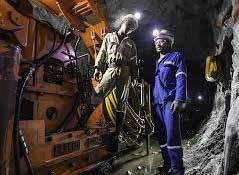
diesel-powered
On Wednesday, 21 December 2022, the Minister of Mineral Resources and Energy declared, by notice under GNR.2908 in Government Gazette No. 47790, that sub-regulations 8.10.1.2(b) and 8.10.2.1(b), of regulation 8.10 of the Mine Health and Safety (“MHS”) Regulations, came into force and were effective from the date of said publication. In summary, these sub-regulations require the employer at a mine to provide for the “means”, also known as the so-called Prevent Potential Collision System (“PPCS”), to automatically “retard” (and “stop”) diesel-powered Trackless Mobile Machinery (“TMMs”) to prevent potential collisions between diesel-powered TMMs and pedestrians; and between diesel-powered TMMs and other diesel-powered TMMs, respectively.
Primary duty with the employer
The primary duty to comply with the requirements of the said sub-regulations, rests with the employer, at a mine, for purposes of the Mine Health and Safety Act, 1996 (“the MHSA”). For those employers that have
diesel-powered TMMs at a mine, and where there is a “significant risk” of the occurrence of the categories of collisions as set out in subregulations, the expectation is that the employer must comply with such regulations. This would mean that employers must ensure that their existing fleet of diesel-powered TMMs used at a mine are equipped with such PPCS.
Significant risk determines obligation
Regulations 8.10.2 of the MHS Regulations require employers to take “reasonably practicable measures” to ensure that persons are prevented from being injured as a result of collisions between diesel-powered TMMs, and/ or collisions between diesel-powered TMMs and pedestrians. The aforementioned imparts discretion on the employer to implement such measures at a mine, which takes into account the standard prescribed in the MHSA of “reasonably practicable.”
It should be noted that the regulatory obligation to provide the “means” or so-called
PPCS, as part of the above “reasonably practicable measures”, only arises where there is a “significant risk” of the respective categories of collisions as set out in the sub-regulations. It is further important to note that to fall within the regulatory obligation, the risk must be significant. For instance, if there is a risk of such collisions at a mine, but such risk is not significant, then the regulatory obligation would not apply to such mine and employer.
Comprehensive risk assessment
Whether the risk of the relevant collisions is “significant” at a particular mine, would be informed by the conduct of a comprehensive risk assessment process conducted at such a particular mine, as envisaged in section 11 of the MHSA. Each mine will yield different results depending on the particular circumstances at each mine, and will be informed by way of example and by, amongst others:
• Previous incidents at a mine involving collisions between TMMs, and the statistics related thereto. The nature or extent of the risk of such collisions occurring at the operations should be determined. Also the effect of any such collisions (i.e. fatal, injury or merely minor property damage, etc.). The frequency or reduction of such incidents at the operations would also be considered, for instance, since the implementation of safety measures or controls, etc;
• The interaction (and means of separation) between TMMs at the various areas of a mine;
• The existing measures or controls in place to mitigate the risk of collisions between such TMMs at each mine; and
• The requirements of “reasonably practicable” etc.
• If there is a significant risk of the relevant collisions at a mine, then it would be incumbent on the employer to ensure that it has appropriate implementation plans/schedules/ timetables in place, in relation to compliance with the requirements
2 Mining Business Africa |March - April 2024 Collision Avoidance Regulations: South Africa
Operators of a
Trackless Mobile Machine underground
contained in sub-regulations. It would be prudent for the employer to inform the regional regulator of its implementation strategy. If potential timelines are provided to the regulator in such context, same should be, as far as is possible, realistic, practicable and made subject to any matters which may be outside the control of the employer or matters that may only be considered at a later stage that may influence any potential implementation.
• Should the compliance with certain of the duties and obligations (as set out in regulation 8.10 of the MHS Regulations) be impractical and/or burdensome on the employer, a potential option to consider is an application for exemption (from all or certain sub-regulations or requirements therein) which may be made to the Minister of the Department of Mineral Resources and Energy (“DMRE”) in terms of section 79 of the MHSA. Essentially, an employer may make an application to be exempt from the application from the requirements of the sub-regulations. Each application will be dealt with on its own merits and, likely, on a stringent basis by the office of the Minister of the DMRE considering same. Accordingly, succinct and detailed reasons would have to be set out therein, as to why exemption is appropriate in the circumstances.
Compatibility of PPCS to fleet
In several cases, Original Equipment Manufacturers (“OEMs”) of diesel-powered TMMs do not supply TMMs with PPCS for use at a mine. As such, the employer would be obligated to source compatible PPCS (and related interface and/or communication systems) from specialist OEMs providing such systems. In doing so, employers also have to take into account the compatibility of such systems to their entire fleet of diesel-powered TMMs (all of which are not likely from the same OEM, year, model, specification, etc.), to ensure that same is tested (in the various mining environments and operational circumstances that may exist at a particular mine) and consider the need to modify and/or replace (due to year, age) certain TMMs
to ensure compatibility. The exercise, to say the least, involves the outlay of significant capital expenditure and the requirement to assess, test and implement, in a very limited period of time.
As it stands, and potentially, employers who are not compliant with the requirements of the sub-regulations may be subjected to, amongst others, possible instructions from the regulator to halt/stop mining operations (or TMM operations), administrative fines and/or criminal liability, etc.
Practical complexities
However and whilst the regulations may have good intent, it is unfortunate that the sub-regulations as gazetted do not provide for any grace or transitional period. Apart from the cost implications and possible penalties, the practical complexities of investigating, acquiring and implementing systems may also result in matters which may be beyond the control of the employer. This may include, amongst others:
• That an employer will have to rely on collaborative efforts between multiple and respective OEMs. This may, in itself, take an extended period, i.e. selection, compatibility, negotiation, contract, testing, etc. OEMs will also have to consider the potential for further product and risk liability, and the OEMs will also possibly have to revise and implement additional measures to mitigate same;
• Even assuming that OEMs are willing to collaborate, the testing and practical application of such systems at a mine will, in all likelihood, take an extended and unpredictable period, with “trial and error”. Further, this will depend on the results that same will yield at the relevant time, taking into account the health and safety of all persons (the improper introduction and implementation of such systems may create further risks); and
• The immediate availability and supply of such systems from OEMs, for the population of all relevant TMMs at a mine.
Opportunity for Engagement
There is some respite, though. In several regions, the regulator (in the form of the office
of the regional Principal Inspector of the Mine Health and Safety Inspectorate of the DMRE) has provided employers with the opportunity to engage with the regulator and submit implementation plans/schedules/timetables in relation to compliance with the requirements contained in sub-regulations. This process, however, is not uniform (across the various regions) and is subject to the regulator’s ultimate approval regarding any periods and proposals provided in such implementation plans/ schedules/timetables.
Employers as forerunners
In the bigger scheme of things, notwithstanding the aforementioned challenges, the subregulations open a new chapter in the drive to mitigate the collision of mining vehicles. Employers in South Africa (in conjunction with OEMs) have an opportunity to be the forerunners in the investigation, design, installation, testing, certification and utilisation of such “means” in various mining environments. This brings about opportunities for OEMs to develop new and innovative systems for application at a mine, locally and internationally.
Thus, to ensure compliance with their respective health and safety obligations in terms of the MHSA, OEMs and employers would enter into partnerships to test such systems in “real world” mining environments, which vary and differ from operation to operation. The collaborative arrangements between OEMs and employers will assist in implementing safe and healthy parameters for such systems to operate in such environments.
ENS is the only law firm in Africa with a dedicated Mine and Occupational Health and Safety team/department. Its practitioners specialise in providing advice and assistance to an array of clients in, and outside, the mining industry. They provide practical and innovative solutions in complying with the legislative requirements; opposing prejudicial regulatory oversight and enforcement; appearing on behalf of clients in legal proceedings, as well as assisting clients with the preparation of exemption applications in terms of section 79 of the MHSA.
Mining Business Africa | March - April 2024 3 CONSULTING EXPERTISE VISION RESOLUTION ACTION | | | Expert Witness Services for Legal Proceeding Forensic Delay Analysis BIM & 5D Planning AGILE Project Management Services Alternative Dispute Resolution Claims Advisory Project Planning & Control +27 11 234 8410 admin@evraconsulting.com
AI Gives Workers the Voice to Monitor Fatigue
WOMBATT-VOZ is a voice-based technology originally developed for fatigue prediction among astronauts. So far, the technology has achieved groundbreaking success in multiple industries. Now, inspired by the outcome, the application team at WOMBATT, the technology’s developer, tell MINING BUSINESS AFRICA that they see immense opportunities for the innovation’s deployment in the African mining sector.
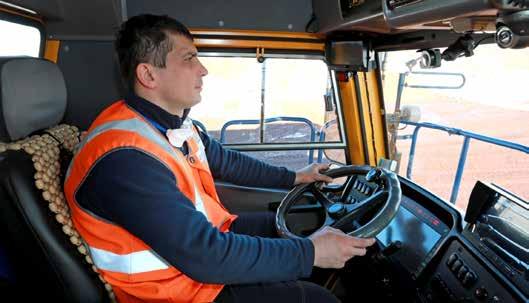 By Jimmy Swira
By Jimmy Swira
Necessity is the mother of invention, so goes the saying. And this would apply to the WOMBATT-VOZ, a groundbreaking fatigue risk prediction technology.
Interestingly, what started as a long-duration Space travel project with a scope limited to the client‘s brief, has opened the door for application in multiple industries and activities.
Research & Development
The European Space Agency (ESA) in Noordwijk, The Netherlands, requested WOMBATT to develop a new tool to monitor astronaut fatigue risk for the manned mission to Mars. Thus, precision was key and in addition, the technology adopted should be non-intrusive and predictive.
WOMBATT-VOZ Voice technology
Usually, all current fatigue technologies are based on detection, raising an alert as or just before the microsleep actually occurs. And so, for ESA, it was important to have a robust predictive fatigue solution that was not intrusive for use in Space, as well as GDPR compliant. This culminated in WOMBATT-VOZ Voice technology.
Accordingly, WOMBATT performed a research and development project from 2014 to 2019. After the development of the voice-based generative artificial intelligence algorithm, the tool passed the ESA Factory Acceptance Tests, scoring 90% accuracy in predicting the risk of a fatigue event occurring up to five hours in advance.
Later, in 2019 and 2020, the product was further developed for commercial use in combination with WOMBATT’s patented realtime fatigue monitoring and reporting solution.
On the record-breaking scale of fatigue prediction, Emma Verhardt, WOMBATT’s team leader, comments: “Exceptional accuracy combined with non-intrusive user friendliness sets our new fatigue technology’s performance apart and makes it a game changer.“ Indeed, the technology continues to receive glowing reviews across the industry.
Meticulous planning and thorough execution
The technology’s plaudits are well-merited. It is a fitting product of meticulous planning and thorough execution.
Available options
WOMBATT’s R&D team explored the available options they could exploit. They considered three main ways the body expresses fatigue to the outside world: Electrode-based, Videobased and Acoustic-based.
Then, to arrive at the most effective solution, the team examined four key fatigue monitoring parameters in the industry and on the road:
• Biological parameters e.g. from the voice;
• Vehicular parameters, e.g. lane deviation;
• Physical parameters, e.g. yawning and head nodding; and
• Mathematical parameters, e.g. sleep/wake times, circadian rhythm.
1. Two parameters
Distinctly, the WOMBATT-VOZ Voice technology incorporates two out of the four possible parameters - a biological parameter (voice) and a mathematical parameter (sleep/wake). Justifying the selection, Verhardt explains, “The combination of two parameters consistently increases the accuracy of fatigue risk prediction over time to levels well above 90%, and complies fully with the oil and gas industry standard ANSI/ API 755 recommended practice 2nd ed 2019. Research has proven that human physiological fatigue effects are almost infinitely variable, so a two-step process in managing fatigue is more accurate than relying on the effects of just one parameter.“
Verhardt demonstrates the effectiveness of the voice-based system: “The voice is actually a powerful window into our body. This is because our voice is a muscle, and when we are feeling fatigued our muscles will start to become fatigued as well. We have all felt that at some point in our lives, some more often than others. However, the voice muscle is the only muscle that can express fatigue (amongst other things) via acoustics without physical contact.
So, what we have done is taken the acoustic data coming from the voice, which expresses developing fatigue, and combined it with our generative AI to build an individual voice model for each user, creating a technology that can predict fatigue up to 4 to 5 hours ahead of time with 90% accuracy. Without a doubt, what makes WOMBATT-WOZ cutting-edge is leveraging AI.
4 Mining Business Africa |March - April 2024 Voice-based AI Fatigue Prediction for Mining Projects
Operator fatigue is a high safety risk








Voice-based AI Fatigue Prediction for Mining Projects
The WOMBATT generative AI
The WOMBATT generative AI is data-based, so it is always adapting and learning the unique characteristics of each user’s voice. To complete the product the technology is linked into the WOMBATT management system which allows operations to plan both for and with fatigue before it becomes an ad-hoc risk or event. WOMBATT has integrated a stoplight system (green, orange, red) in which companies can integrate the results into their fatigue risk management protocols.
WOMBATT-VOZ’s Features
As a result of the integration of generative AI, the technology has proved effective. The enduser can rest assured of the following benefits:
i. High accuracy and non-intrusive
WOMBATT-VOZ achieves high levels of accuracy in the field without additional hardware and is non-intrusive for workers. It is a system that can be used broadly within any organisation, for haul truck drivers and service equipment operators, but just as well as for workers in the processing plants.
ii. Integratable
Furthermore, as an SaaS technology, WOMBATT-VOZ can be integrated with dispatch systems or on existing hardware already present at the mine. It can be used as a stand-alone service or as an additional service to existing detection technologies complementing the risk management systems in place.
iii. User-friendly
There is always concern with new technology and how mineworkers adapt to it. WOMBATTWOZ caters for this. It is available as an app which anyone can download free of charge. So it can be on a mobile phone, a tablet or integrated into onboard systems.
“The app itself does not store data and record without the worker’s intervention. For us, this was specifically important during the development to make sure that the worker has agency.
To sketch an outline, the technology requires an intervention of under { five minutes} per day. The worker keys in their code and has to tell the system to start recording by pressing the button. The worker can then see when the recording starts. After 8 seconds, the option to stop the recording is available, and after 15 seconds it stops on its own. The recording can be done anywhere and anytime. In order to comply with the two-step process required by the oil and gas industry fatigue standard ANSI/API 755 Recommended Practice, the worker is required at the first recording of the day or shift to also input their sleep/wake data, i.e. time to bed and wake up time. All subsequent interventions by the worker that day are just voice, and a smart
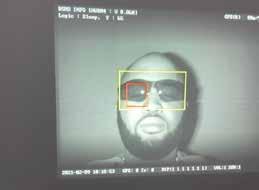
band or smartwatch can optionally be integrated into the system to automatically record and upload sleep/wake data to the WOMBATT reporting cloud at the start of each shift.
What makes it so effective based on what is available in the field, is that workers gain awareness of their developing fatigue levels. Then, they integrate this knowledge into their personal lives, making them more well-rested before starting work. WOMBATT has found in the field that as the AI becomes more knowledgeable about the individual user’s sleep characteristics over time, and becomes more and more accurate, workers adjust their sleep time. Where a worker has sleep deprivation, the technology feeds this information back to them and they increase their sleep times. WOMBATT has seen in the field a direct relationship between increased sleep times and lower fatigue alerts.
Huge potential in mining environments
WOMBATT-VOZ has a huge potential to enhance fatigue management in mining environments. It is a new generation of fatigue prediction solutions, different from products available on the market. Consequently, by predicting fatigue up to five hours ahead, the technology enables companies to make the most out of risk management and fatigue training.
Deployment
Verhardt shows how WOMBATT-VOZ is deployed, “Lack of sleep is almost always a choice. Of course, there are exceptions where workers have medical issues such as sleep apnea, or perhaps a new family member is keeping them up at night. However, for the majority of us, sleep deprivation and the resultant fatigue is, in fact, a choice. So, with this in mind, raising fatigue awareness already tackles a large part of the problem. We advise users to make a minimum of three recordings per day – the first at shift start to act as a fitness for work, the second during the middle of the shift to assess fatigue risk over the following 4-5 hours and the last as a fitness to drive home measure.“
Typically, most road accidents due to fatigue, for example, occur on the commute home. And so, by giving workers insights into their actual fatigue risk levels, WOMBATT-VOZ creates an awareness of fatigue risk among all employees using the technology which is just as important as a company’s role in fatigue management. This is considering that lack of sleep starts with the employee.
Success
Significantly, WOMBATT-WOZ has registered great success in the reduction of fatiguerelated risks. The technology has been running for four years in the field in multiple industries and both management and workers are impressed with the system’s accuracy in predicting the user’s fatigue risk level. Workers and unions especially appreciate the fact that workers have agency, in that users can decide when and where to make their voice recordings – they are not being continually observed or measured in real-time which is a major problem with all other existing fatigue detection systems.
WOMBATT has developed fatigue risk management protocols for monitoring the technology’s performance within companies. Fascinatingly, thus far, the team at WOMBATT have no records of fatigue incidents on the job. Recently, they received customer data on a reduction in safety incidents of 61% in processing mills since the installation of WOMBATT-VOZ, and customers have observed that fatigue risk within the shift decreases over time.
Significantly, an interesting and general finding has been that at the start of WOMBATTVOZ implementation at a site, sleep time is relatively lower with commensurate higher fatigue risk. In contrast, for sites that now operate the system regularly, there has been an increase in sleep time and a decrease in fatigue risk.
Regarding the data, Verhardt deduces, “In general, the risk reduction demonstrates that fatigue risk management as a predictive measure contributes to the overall safety of the worker. It allows workers to operate more efficiently and alert them to developing fatigue risk during a shift, keeping both them and fellow workers safe.“
WOMBATT recommends WOMBATT-VOZ to African mines. In addition, Emma Verhardt believes that with non-intrusion, worker agency and very high forward-looking accuracy, unions can easily support the system as well. “It is in everyone’s interest to ensure we all stay safe on the job.”
WOMBATT is an Australian-origin fatigue management company, with 25 years of worldwide experience in monitoring, managing and eliminating the fatigue of mining haul truck operators and road transport drivers.
6 Mining Business Africa |March - April 2024
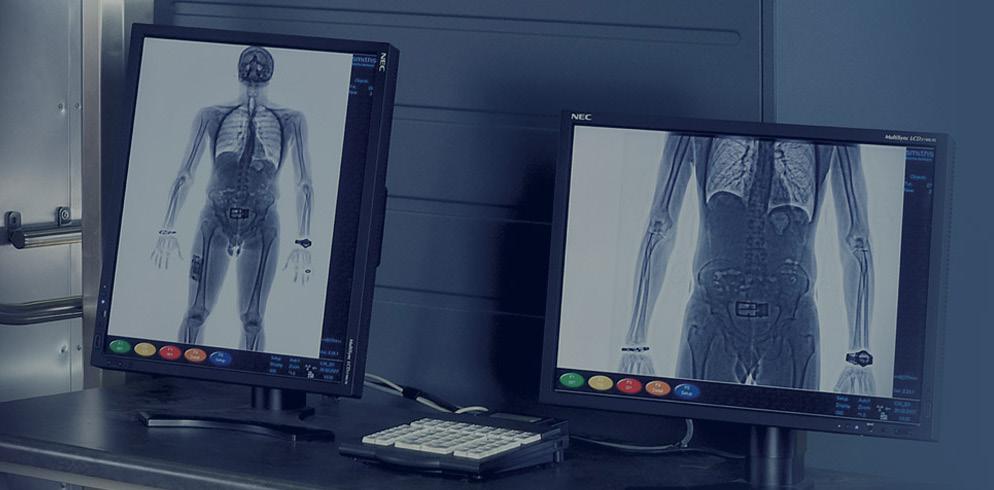
Body Scanner Solutions
Dual view X-ray Body scanner (BS16HR-DV)
For customers who place importance on the prevention of smuggling of precious metals and gems, the Full Body Scanner is an essential security tool. The new machine offers outstanding image quality of the entire body with high image resolution and a flicker free display making it an effective tool for the detection of; Precious stones (including diamonds) and precious metals, Contrabands and threat detection (weapons, explosives, narcotics, etc.), and Objects Concealed internally or externally.
Xscann Technologies boasts an inhouse developed X-ray Management Software (XMS)
Xscann X-ray management software (XMS) Includes: One-off software licensing, Matrix configuration for gender segregation, various access control integration (e.g., Babylon, Impro, Opto, etc.), Algorithm to ensure that personnel will not be subjected to radiation exceeding 1mSv per annum, Logging of personnel radiation data for archiving, Reports generator.
XMS reporting includes: X-ray totals by radiation, X-ray totals by name, Over quota individuals, Excessive entries, Excessive dummy scans, Excessive holds, Scan logs, search logs, etc.
Address: 6 Guernsey Drive, Longmeadow East, Edenvale, 1610
Tel: +27 11 608 1504 | Fax: +27 11 608 1570
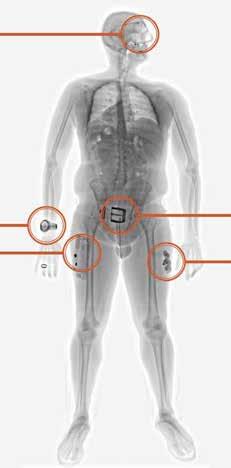
Email: axel@xscann.com, charl@rdscreening.com, rudzani@xscann.com
Web: www.xscann.com | Partners: www.ceia.net; www.smithsdetection.com

Mining Business Africa
GLASSES WATCH
BELT
COINS CELLPHONE
Competent Operators, Reliable Results
While the penetration of X-ray fluorescence (XRF) spectrometers has revolutionised ore sample analysis, it has not eliminated the need for best practice. Requisite operator competence has never been more critical to producing reliable results. This is what XRF specialist Maggi Loubser points out.

Advances in electronics and detectors, as well as software development, have made X-ray Fluorescence spectrometry seemingly effortless for the end user. As a result, XRF spectrometers, like other analytical instrumentation, have shrunk to such an extent that a geologist or operator can now easily have his own handheld XRF spectrometer with him in the field. As result, hand-held spectrometers have changed the game in mineral sample analysis.
Disruptive development
Hand-held XRF spectrometers have without any shadow of a doubt been one of the most disruptive developments in mining and exploration in the past decade. Suddenly the laboratory could be taken to the ore body without the
need to wait for long laboratory turnaround times. An exploration team can get an in-situ indication of the ore grade, and the mine operators on where a seam runs.
Not a magic wand
However, while handheld XRF analysers offer incredible convenience, the catch is that the physics behind the technique has not shrunk. The physics of XRF spectroscopy has not changed nor the statistics of representative sampling.
For all its wonders, a handheld XRF spectrometer is not a magic wand. It can only analyse that which you put in front of that sample aperture, and the X-ray photons making it to the detector are even fewer due to geometry, the density of the sample, matrix effects etc.
This suggests that if the operator (the person behind the instrument) does not have insight into how data is generated and what the limitations are, gigabytes of meaningless data can easily be produced. The operator needs the requisite competence.
The biggest challenge that arises is where previously a carefully calculated volume of sample, representative of the ore body/seam was sent to the laboratory, where its size was decreased through a carefully designed comminution process to produce a representative analytical aliquot still representative of the original bulk, now, the operator just analyses unprepared random direct measurements and expects the data to correspond to the laboratory results.
8 Mining Business Africa |March - April 2024 Hand-held X-ray Fluorescence (XRF) Spectrometers in Ore Grading
With Handheld XFR spectrometers offer the convenience of analysis at the right at the coal face of mining activity
Unsurprisingly, this is the reason why exploration geochemists have been and are still grappling with representative sampling since the 1950s when Pierre Gy (Gy P.M. 1976) published the first of his many works on the subject. (Esbensen 2014-2020).
Vital steps
Thus, there are vital steps that an operator has to follow to get reliable results from handheld XRF spectrometers. Worth mentioning are the following:
1. Comparison between in-situ to laboratory analyses
For this reason, it is essential to experimentally compare the uncertainty from in-situ analyses to laboratory analyses, then, combine it with a cost/ time benefit analysis, to decide whether the uncertainties are acceptable. Without practical evaluation of the results obtained in-situ, and an understanding of the uncertainties, the instrument is no more than a random number generator!
2. Increasing analytical accuracy
Fortunately, many steps can be taken
in the field to increase the accuracy of results a hundredfold in sample preparation. These include:
i. Grinding and homogenising samples
Grinding samples fine and homogenising samples cause an exponential increase in analytical accuracy. In the laboratory, the sample is ground to a fineness small enough for the longest wavelength photons (light elements) in a sample, to escape the sample with equal probability than a shorter wavelength (heavier element). Fortunately, today there is a lot of portable equipment used for the task. These vary from small manual crushers and mills operating with a small percussion drill and batteryoperated grinders, or an angle grinder with a capture vessel enabling one to cut through a rock and collect representative sample dust.
ii. Drying samples
Drying samples is another vital process. Samples are dried to eliminate the effect of moisture on absorbing long wavelength light elements. In the laboratory they are ignited to get rid
of volatile components like CO2 in a measurable fashion. This enables accurate recalculations of elements the XRF cannot determine due to their low atomic number, and followed by fusion to destroy the mineralogy and minimise matrix effects. In the field, a UV lamp can suffice in drying samples enough to make light element analyses more accurate.
iii. Optimal instrument calibration
To ensure the instrument is optimally calibrated for your specific matrix is crucial. Typically, the factory calibrations are executed with a wide set of matrices to cover as many matrices and large analytical ranges as possible, but at the cost of accuracy for a specific matrix.
Thus, it is crucial to evaluate the factory calibration on your material and use a slope and intercept adjustment with certified reference materials in your matrix, also called derivative calibrations. If your spectrometer has the ability, do a matrix-specific calibration on your material, or provide the factory with a set of reference materials in your matrix and ask them to do so at the time of purchase.

Mining Business Africa | March - April 2024 9
Hand-held X-ray Fluorescence (XRF) Spectrometers in Ore Grading
In addition, just as in a geochemistry laboratory, daily check samples are crucial to gauge the stability of an instrument. Typically, the sample window is often polypropylene, and it could be broken without anybody noticing, except that measurements will suddenly be much higher as the extra absorbing layer between the sample and detector is gone.
An instrument usually comes with a factory check sample, and this is important, because this data can always be compared to the factory commissioning data, but it is important to have a stable control sample including your elements of interest. This is even more important when a project uses multiple handheld instruments. In this case, you need a set of monitor sample data if you want to combine data from different spectrometers.
As a rule, handheld XRF spectrometers are incredibly robust and stable. Different from high-power systems, they do not decrease in sensitivity over time. Thus, when a tube or detector breaks, it breaks. The biggest agent of deterioration is operators who drop instruments or puncture detectors by pushing the instrument directly against protruding rocks.
iv. Application of matrix correction software
Ultimately, all these steps ensure that the sophisticated matrix correction software is applied effectively to give the most accurate results.
v. Determining a representative sample
A representative sample that is as accurate as possible must be determined. First of all, it is important to calculate how many in-situ analyses are necessary over a given area/volume to give representative results. Follow the same process as you would have done to determine your original carefully designed sampling plan for collecting material to send to the laboratory. Again, this involves taking the largest particle sizes, the density of the country rock, and the concentration of elements of interest into consideration. Compare these samples with laboratory analyses to calculate your uncertainty.
Selecting the right instrument
Plainly, it is critical to make informed

decisions when it comes to selecting instruments used for an application. Usually, the lower-power instruments are used for metal sorting or heavy element analyses where the fluorescence yield of the elements of interest is high. For accurate light element analyses (Mg –S), a silicon drift detector is an absolute prerequisite and some instruments now come out with graphene or equivalent detector windows that absorb less of the radiation coming from the sample leading to much higher sensitivity for light elements. For instance, Cl is a nightmare on a Rh tube instrument operated in an air atmosphere due to Argon peak overlap.
Higher-end instruments are calibrated with different power and filter settings for different parts of the periodic table and so all elements from Mg to U can be covered in three phases. Always ensure you have access to the manufacturer’s calibration tables to ensure your analytical range falls within the calibrated range, else a type of standard adjustment will be necessary to extrapolate the calibration maximum. Unfortunately, if you have a very unique matrix, a slope and intercept adjustment may not be enough to compensate for the difference in your material and the general factory calibration.
In a nutshell, there are several factors to be considered when determining the type of XRF instrument to be used for a sample, specifically:
• Always consider your application and the fact that the needs may change over time.
• Get the most robust instrument you
can afford with the most relevant factory calibrations you can afford.
• Ensure you can get good support and service from the supplier –often people buy less expensive instruments on the internet only to find out the manual is unreadable, and no local support is available.
• However, it is important to make the most of the convenience handheld XRF spectrometers offer. The most important issue is to commission your instrument properly before commencing any project. Do repeatability and reproducibility studies, test your sampling frequency, and test the accuracy against reliable laboratory analyses. Set up quality control protocols for each instrument and collect and store the data diligently should adjustments to data be necessary at a later stage. Remember, the spectrometer has no psychic abilities, it can only analyse that which the operator places in front of the analyser window!
Dramatic transformation of exploration geochemistry
From the foregoing, the main takeaway is that there is no question that handheld XRF spectrometers are probably the most exciting development in X-ray Fluorescence spectroscopy in the last decade. Since the silicon drift detectors were developed making light element analyses possible, this tool has transformed the capabilities of exploration geochemistry dramatically. However, the role of competent operators in producing reliable results has never been more critical.
Gy, P.M. 1976. The sampling of particulate materials – A general theory. International Journal of Mineral Processing, 3(4):289-312
Esbensen, K.H., et al. 2014-2020 Sampling Columns. Spectroscopy Europe Asia. https://www. spectroscopyeurope.com/sampling
Maggi Loubser is a Bruker-appointed Application specialist in South Africa and has 35 years of XRF experience and about 15 years of handheld experience. She consults intensively in the mining industry, especially handheld spectrometers. Currently she is based at the University of Pretoria.
10 Mining Business Africa |March - April 2024




How to OBTAIN™ Improved Throughput and Sorting Precision
Hard on the heels of the groundbreaking launch of OBTAIN™ at the Investing in African Mining Indaba, Stefan Jürgensen, Software Team Leader at TOMRA Mining, fields questions from Mining Business Africa. In the interview, he elaborates more on the value OBTAIN™ will add to X-RayTransmission (XRT) singleparticle sorting tasks in mining, and underlinesTOMRA’s commitment to supporting mining companies interested in the software.

MBA: On their own, TOMRA’s flagship X-Ray transmission (XRT), Near-Infrared (NIR) and Laser sensor-based sorting technologies ostensibly have been working perfectly, breaking milestones in recovery. Why has TOMRA decided to tap into deep learning through OBTAIN™?
SJ: TOMRA is continuously evaluating new technologies that can further advance sensorbased sorting. We strive to offer the most sensitive and robust sensors, the most energyefficient and precise ejection systems, and the most advanced and reliable data processing technology. Although the current hype about large language models directs the most attention to human interaction with AI, there are unique features of the Deep Learning approach that perfectly augment our current XRT sorting technology to enhance throughput without compromising sorting quality. OBTAIN™ adds an extra layer of intelligence.
MBA: Does the introduction of OBTAIN™ suggest there are inherent limitations with the capabilities of AI-powered XRT, NIR and Laser sorters? Please elaborate.
SJ: Innovation is a continuous journey: over the past three decades, TOMRA has been
at the forefront of developing cutting-edge sorting solutions for mineral processing. Every new generation of sorters has built upon the foundation of its predecessors, incorporating advancements in technology, efficiency, and accuracy. With the introduction of OBTAIN™,

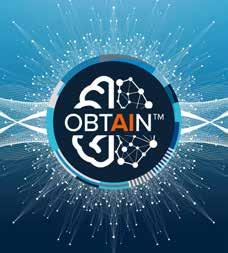
we are once again pushing the boundaries of what is possible in sensor-based sorting. We are maximising resource utilisation and promoting sustainability.
MBA: Demonstrate how the software, through data from deep learning, can bring single-particle precision to high-throughput particle sorting.
SJ: Single-particle sorters generally need not consider the interaction between neighbouring particles in material streams. This approach allows for precise analysis of each particle’s properties and can increase the accuracy of the sorting decision, but at the cost of a throughput suitable only for laboratory-scale applications. With OBTAIN™, TOMRA bridges the gap between precision and throughput. We use Deep Learning to apply knowledge about particle characteristics that enable the same type of analysis used for single-particle sorting at throughput rates of tens of thousands of particles per second, even when particles are clustered.
MBA: We notice that, despite the hype about AI, which is almost akin to religious fervour, TOMRA has been leveraging this groundbreaking technology since 1993. How does this experience help
12 Mining Business Africa |March - April 2024 Ore Sorting Software
Albert du Preez, Head of TOMRA Mining
Tomra’s COM XRT 2.0 Sorter installed
TOMRA’s R&D team when devising solutions?
SJ: Artificial Intelligence (AI) is a vast scientific domain, with numerous conferences each year, even for small subtopics within the field. Like most technologies, AI lacks a universal “Silver Bullet”; instead, there are many different approaches for its implementation and utilisation. Furthermore, today’s sensor-based sorters feature sophisticated multi-staged data processing pipelines.
TOMRA’s substantial experience in the field of AI and its application to sensorbased sorting, and the collaboration of our teams of experts allow us to select the most suitable AI technology for each part of our processing pipelines. OBTAIN™ represents the convergence of cutting-edge technology and decades of expertise.
MBA: How does a mine incorporate OBTAIN™ into its existing TOMRA ore sorting process? How is the team responsible at OBTAIN™ involved?
SJ: TOMRA assesses the benefits of using OBTAIN™ for the mine’s sorting needs and offers OBTAIN™ upgrade packages if they are advantageous for the mine. These packages enable seamless integration of OBTAIN™ into the mine’s existing COM XRT sorters. The process of installing OBTAIN™ is straightforward and can be carried out by any trained TOMRA Service technician. All new COM XRT sorters are ready for OBTAIN™ as an optional feature.
OBTAIN™ can improve the performance of TOMRA’s COM XRT sorters in throughput and sorting quality. The achievable improvements depend on many factors like the feed stream’s PSD and other site-specific requirements. Therefore, we recommend getting in touch with our Sales representatives. In our Test Center, we can determine in which way OBTAIN™ can be put to best use for each COM XRT sorter.
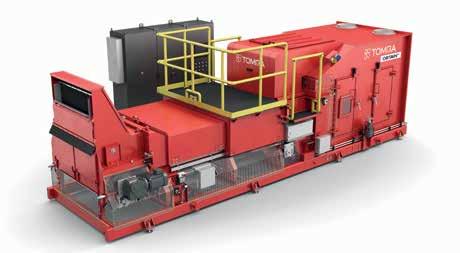

MBA: In a nutshell, how do mining companies benefit from adopting OBTAIN™ in sensor-based ore sorting processes.
SJ: By implementing OBTAIN™, mining companies achieve consistent performance from sensor-based ore sorters across a wide range of throughput. This flexibility allows them to either process more material or improve sorting quality. Additionally, the statistical data collected from the sorted material streams becomes more accurate.
MBA: Last but not least, TOMRA always sees a lot of opportunities in the African mining sector. What are your plans to serve this lucrative market with revolutionary sensorbased ore sorting technologies in 2024?
SJ: At TOMRA, our commitment is to deliver top-tier sorting technology to the African mining industry. We continually strive to innovate in sensor-based sorting, and we are already preparing to unveil exciting new features.

Mining Business Africa | March - April 2024 13
Stefan Jürgensen
Tomra’s COM XRT 2.0 sorter
Identifying New Opportunities
The Industrial Valve Summit (IVS), one of the biggest showcases for the global valves sector, is scheduled to take place in Bergamo, Italy from 15 to 16 May 2024. Mining Business Africa (MBA) finds out from Luca Pandolfi, Industrial Valve Summit (IVS) Project Manager, about what is in store at the event amidst groundbreaking advances in valve technology.

MBA: Various players in the industry are looking forward to the Industrial Valve Summit (IVS). Looking back, what do you particularly consider as milestones of the IVS postCovid-19 pandemic, in terms of attendance numbers and diversity of participants (exhibitors)?
LP: Despite the international travel restrictions and the delicate global scenarios that were taking place in 2022, the fourth edition of IVS drew a record 12,000 visitors from over 60 countries, as well as almost 300 exhibiting companies. This was an increase of 17% compared to IVS 2019.
Two years ago, we saw a drop in registrations from the Far East countries. However, we expect that the Summit edition, which is just around the corner, will have many more operators from this geographical area participating. The growth trend was

noticeable from the very first moments of the exhibition.
The third edition of the Summit attracted over 250 companies and 10,800 visitors to Bergamo. This was 36% more than the 8,000 attendances recorded in 2017. Further back, the number trebled in comparison with the 3,500 accesses recorded in 2015.
Generally, this data indicates how IVS has consolidated itself as an essential event for the entire global supply chain connected to industrial valves and flow control.
MBA: What is the relevance of the event to valve and flow control companies targeting the Middle East and Africa (MEA) region?
LP: The MEA markets represent a very dynamic scenario for the valve and flow control industry, and international
companies are attentive to the opportunities in this area. On the one hand, the Summit will attract important players from the UAE, Saudi Arabia, and the Persian Gulf in general. On the other hand, IVS will represent the stage on which to intercept the major projects in the Oil&Gas field under development in the African continent, including, for example, Nigeria and Mozambique.
MBA: What should we look forward to the IVS May 2024 on the programme’s schedule?
LP: The Summit organisers, in collaboration with VALVEcampus (the event’s scientific partner), have unveiled the IVS 2024 conference calendar: a total of 46 conferences, round tables, workshops, case studies and laboratories, for a more than onethird larger plan compared to the 34 in-depth technical sessions offered at IVS 2022. The programme is structured

14 Mining Business Africa |March - April 2024 International Exhibition & Conference on Valves & Flow Control Technologies
2024
around eight macro-themes: additive manufacturing; digital technologies applied to valves, actuation, and control; sealing and fugitive emissions; valve design and materials for severe services; standardization and standards development; supply chain management; AI applied to mechanical design, procurement and manufacturing; energy transition, carbon capture utilisation and storage. These are complemented by round tables discussing hydrogen, analysing market trends, the Corporate Sustainability Reporting Directive (CSRD), greenhouse gas management and other topics.
MBA: Tell us about new participants with new specialities bringing new dimensions to the event.
LP: The market specialities of the new exhibitors reflect the topical themes on which the industry is identifying new opportunities. These are hydrogen, Carbon Capture Utilisation and Storage and the large-scale distribution of water resources, such as dams and aqueducts.

MBA: Specifically, is there anything related to machine learning AI and machine learning in valves and flow control?
LP: IVS 2024 will have a special area dedicated to artificial intelligence. Exhibitors involved in IA applications in the field of valve production and utilisation will have the chance to exhibit their products and services in a special dedicated area. They will present speeches, company presentations and workshops during IVS.
The ongoing development of AI opens the valve supply chain to new possibilities and renewed
operating models. Noteworthy, the rapid integration of technology into the industrial organisation already represents a competitive advantage for companies in the industry.
MBA: Last but not least, what is the relevance is the IVS 2024 to the global supply valve and flow control supply chain?
LP: IVS has taken on a central role within the sector, generating increasing interest from the industry. The Summit has become a point of reference for EPCs, end-users and technology manufacturers, all of which consider the event much more than just an exhibition. In addition to being a key event in business development, IVS is an international meeting place to read and interpret change, identifying and analysing the challenges of the entire supply chain. IVS offers the opportunity to meet the major players in the global supply chain and to forge new business relationships. Last but not least, it provides an opportunity to delve into technological innovations and examine market evolutions and socio-economic macro-trends.
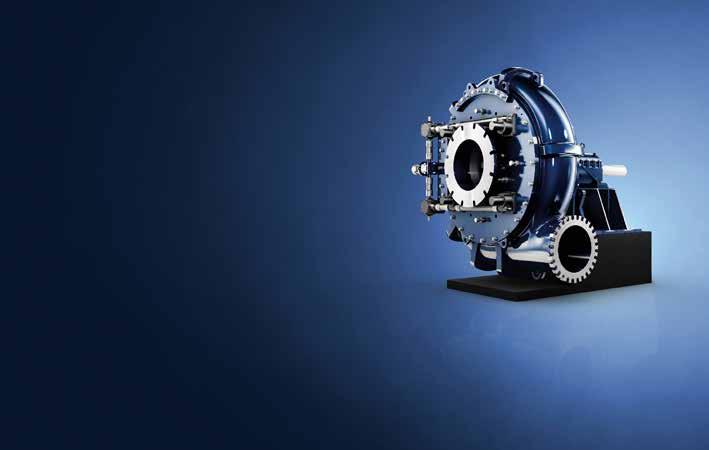
The KSB GIW® MDX pump line delivers proven results in the harshest hard rock mining applications.



Mining Business Africa | March - April 2024 15 GIW® MDX = BEST IN CLASS MILL CIRCUIT PUMP W: www.ksb.com/en-za T: +27-11-876-5600
ME Elecmetal’s integral solutions to improve your production strategies and productivity goals
Take on the unique challenges at your mining operation and positively impact priority KPIs.
ME FIT System is our integrated solutions program for large mining operations. It focuses on creating value for mining processes by quantifying the impact of their solutions while improving key productivity indicators in mineral extraction and processing. Our ME FIT program solutions are made possible through mutual collaboration between our clients and the ME Elecmetal multidisciplinary team. By having an in-depth understanding and knowledge of each site’s operational issues we are able to positively impact their priority key performance indicators: productivity, reliability, availability, safety, efficiency and / or energy consumption. We align with the priorities of our customers, positioning ME Elecmetal as a true strategic partner in mining.
Products and Services that Make a Difference
Mill Liners
Grinding mill liners are subjected to severe impact and high abrasion. They must be manufactured using the best technologies and designs for superior strength and durability. That is why we make sure we offer customers the best possible solutions for every challenge and mill type.
ME Elecmetal analyzes customer operations to determine the ideal combination of design and materials to achieve the optimal performance of their equipment. Whether it is an AG, SAG, ball, tower or rod mill, our innovative liner and alloy designs deliver proven performance, while minimizing costly reline and downtime. We collaborate closely with operators and
plant maintenance crews to monitor wear performance and production rates, customizing each liner for the best possible performance. All variables are considered in this analysis — from the characteristics of the ore and the customer’s operative strategies to their production goals. We identify opportunities for improvement and adapt to challenges as they arise to offer solutions that exceed customer expectations.
Our liners are manufactured according to the highest quality standards and state-of-the-art technology and engineering, resulting in the most reliable, lowest total-cost-of-ownershipsolutions for our customers.
Grinding Media
ME Elecmetal designs, manufactures, and supplies the highest quality forged steel grinding media for SAG and ball mills in the world. Our

16 Mining Business Africa |March - April 2024 Mill Lining Solutions

extensive field experience, engineering and consulting expertise enables us to accurately analyze operational data, so we can support our customers to achieve continuous improvement in their grinding processes. The process begins when we deliver the grinding media to your site and ends when your final product exits the mill.
Our experience and large-scale grinding media production capacity have positioned ME Elecmetal as a strategic partner in the global mining market. Our experienced and knowledgeable sales and application engineers can help you monitor and improve your processes by collecting and analyzing operating data, improving media charging practices and offering solutions to optimize your grinding media consumption and improve throughput.
Crusher Wear Parts and Safety Tooling
ME Elecmetal is the leader in offering wear solutions to crusher operators. We provide wear parts for primary, secondary, and tertiary crushing applications for the mining, aggregate and recycle industries with optimal designs and alloys specifically developed for each
application. We will help tackle any customer challenge, while striving to maximize the benefits we provide. We can adapt to any type of equipment customers may have on site.
With a focus on safety, durability, and easeof-use, ME Elecmetal also offers a full line of Crusher Safety Tooling products designed to help you get the job done safer, faster, and smarter! Our products include:
• Primary corrals
• Dump pans
• Setting fixtures
• Crusher nuts
• Power shackles
• Spider hooks
• Customized solutions
Optimization Tools and Services
There is an increasing demand in the mining industry for technology capable of optimizing processes, equipment, and performance. ME Elecmetal believes there is always room for improvement. We focus on delivering tailormade technology solutions for grinding and crushing applications, with a complete offering
of optimization tools, including wear monitoring, to further improve efficiency and provide our customers with timely information.
ME Elecmetal’s technical support and training goes beyond standard services offered by other suppliers. These services include DEM and FEM simulation services, 3D laser scanning for wear analysis, reline optimization, continuous improvement programs, grinding circuit optimization, and more.
3D DEM Simulations FEA Simulations
Load levels, water percentage, speed, liner design, ball mill size and bolt torque are some of the variables that come into play, and digitization allows these variables to be addressed individually, or in combination to gain a better understanding of the operation.
Contact Us Today!
For more information on ME FIT Solutions and to learn more about how ME Elecmetal can help you optimize your mining processes, visit www.meelecmetal.com or call 480-730-7500

Mining Business Africa | March - April 2024 17





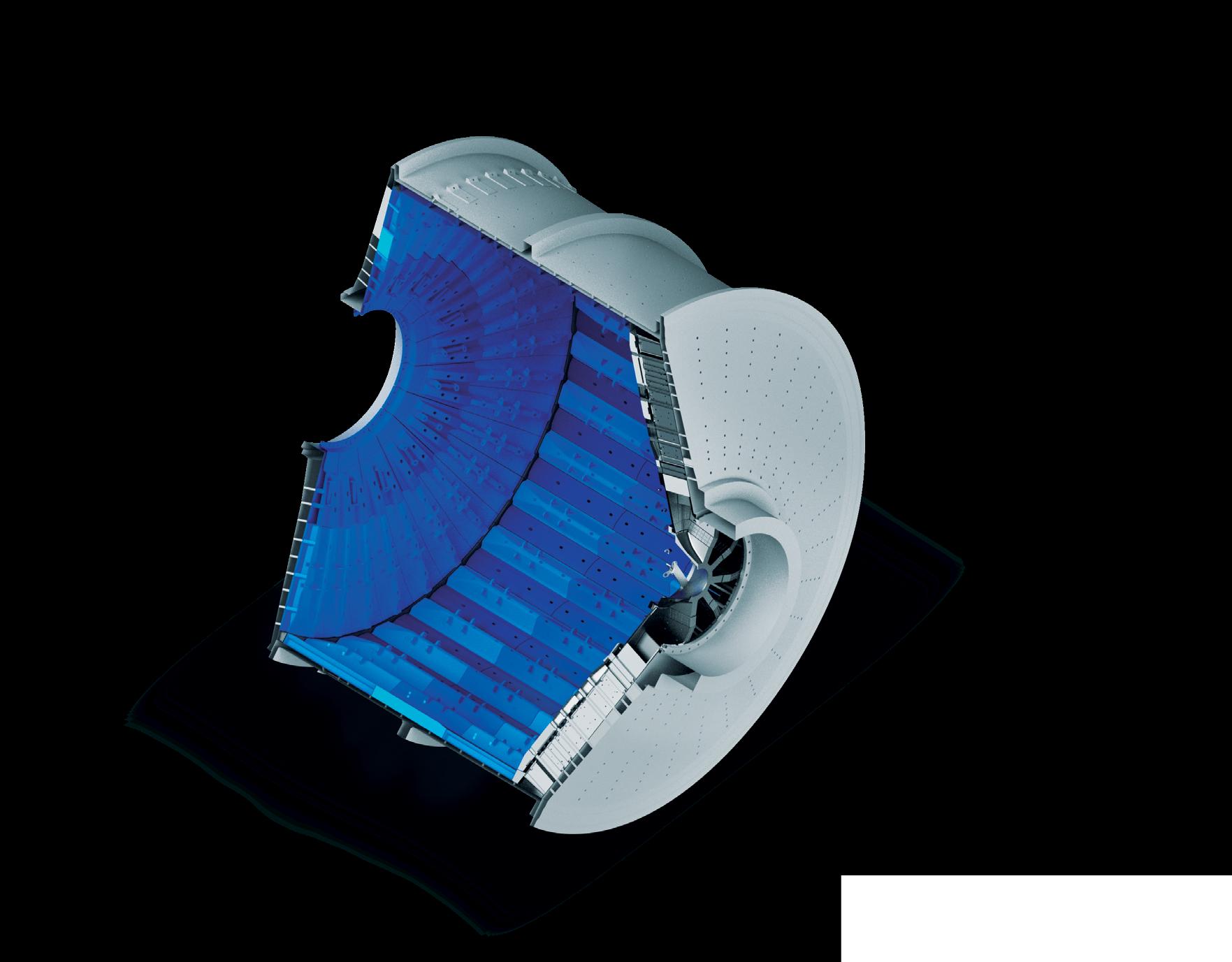



Enhancing the Mining Production Cycle with Loadscan®
Loadscan® is an advanced LiDAR volume scanning and measurement system supplied by SITECH SA (Pty) Ltd
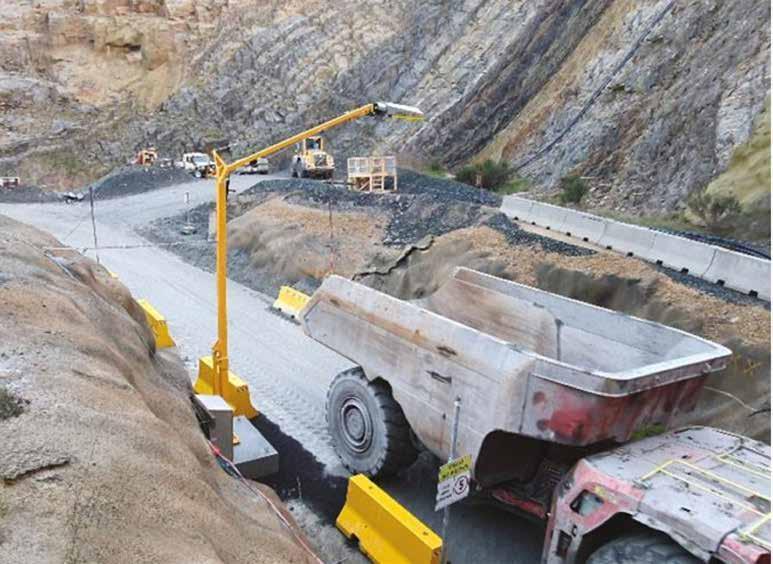
Ensuring profitability, efficiency, and safety in mining operations relies heavily on accurate payload monitoring. However, conventional load monitoring methods are susceptible to errors - leading to financial losses, equipment damage, and safety compromises.
The Loadscan® Mine Payload Scanner (MPS)
SITECH SA addresses these challenges with the Loadscan® Mine Payload Scanner (MPS). This advanced payload monitoring solution utilises the
latest LiDAR technology to optimise truck loading, reduces the cost per ton of hauled material, increases profits, and improves productivity.
The scanner employs state-of-the-art LiDAR lasers, coupled with proprietary software, to precisely measure the volume of material loaded into a truck with an operating accuracy of ± 1%.
The process involves scanning the empty truck to create a reference scan in the database and then re-scanning the loaded truck to measure the exact volume of the hauled product.
The Loadscan mining software provides real-
time reports on volumetric measurements and creates 3D load profiles, allowing identification of underloading, overloading, off-centre loading, or carryback of material. This information enables prompt corrective actions to be taken to optimise loading cycles and improve operator efficiency.
Benefits of LiDAR-based payload monitoring
When it comes to LiDAR-based payload monitoring, there are some immediate benefits that the Mine Payload Technologies (MPS)
20 Mining Business Africa |March - April 2024
Monitoring for Mining Operations
Payload
Payload Monitoring for Mining Operations
brings. The LiDAR-based scanner uses eye-safe technology, it doesn’t require human contact to operate, there are no ongoing calibration costs needed, and it provides load data to an accuracy of ± 1%. Along with this, there is a wide range of long-term benefits that a mine payload scanner brings with it. These include:
• Real-time monitoring and reportingUsing Loadscan’s secure cloud-based MyScanner data management system, a 3D scan is created for every truck coming in or out of the site. These scans can be used to educate loader operators to prevent overloading or off-centre loading, ultimately enhancing trucking cycles.
• Truck bunching occurs when heavily loaded trucks become slower up ramps, holding up other trucks and creating bottlenecks in production. By ensuring trucks aren’t overloaded, you are also ensuring your mine is running efficiently.
• Avoiding carryback to improve operations
- Mine operations are often hindered by carryback as it has a serious impact on productivity, shift tallies, and the number of manual data entries required. By scanning all of your loads with the Mine Payload Scanner, carryback out of the mine is accounted for and can be deducted from shift tallies, improving the accuracy of actual loads shifted.
• Improving health and safety by reducing off-centre loading -This is a difficult issue to identify and quantify on a mine site as both overloading and carryback, along with uneven loading, feed into this problem. However, this doesn’t negate the fact that uneven load distribution adds stress to trucks’ components, reducing their working life and adding substantial costs to your operation. Using
Loadscan’s 3D scanning technology, offcentre loading is calculated and reported within the four quadrants of the truck bin. Truck drivers are then notified by an LED message board and can take corrective action. By reducing both overloading and underloading, the MPS minimises wear and tear, improves production efficiencies, and identifies carryback issues, enhancing the accuracy of actual loads shifted.
• Enhanced Portability and Customisation
- Loadscan’s Mine Payload Scanner (MPS) stands out for its exceptional portability and adaptability, seamlessly integrating into diverse sections of both surface and underground mining operations. This dynamic capability allows the MPS to be strategically relocated and customised to key areas such as transfer tips, shaft bottoms, hoisting shafts, waste- and ore stockpiles, backfill- and rehabilitation sites, and loading bays. Whether tracking truck loads from the critical phases of material transfer (mine-to-plant) or optimising efficiency in stockpile management, the MPS ensures real-time monitoring and reporting. The flexibility and mobility of the MPS empower mining companies to tailor its deployment, maximising its impact on various phases of the mining process.
Case studies of Mine Payload Scanner
In a real-world application, Aeris Resources’ Tritton copper mine in NSW experienced a 9.7% increase in trucking factor after installing a Loadscan® system in 2022. The decision was driven by consistent inaccuracies in previous payload measurement systems and limited forward compatibility with truck fleet upgrades.
A recently released report on the economic benefits of load volume scanning in underground mining further underscores the value of Loadscan’s technology. The study —
UNDERGROUND MINING; Economic benefits of load volume scanning of underground mining trucks — was conducted over seven months at a Central Queensland underground gold mine and revealed issues such as carryback, excessive fuel consumption, and under-utilisation of equipment contributing to unnecessary operating costs and lost revenue.
The study showed that the average load on all trucks could be considerably improved by addressing underloading. This would not only improve loading cycles but also reduce fuel costs, both of which considerably impact profitability. In this case, an increase of just 10% in the average load would be valued at ± $1 million per annum.
Loadscan and SITECH SA
Over 20 years ago, Loadscan invented and patented the original load volume scanner, and since then they have been the market leader in providing certified, accurate and reliable load information. In 2021 the company created Mine Payload Technologies, a specialist mining division within the company, to deliver deeper insights and added value to the sector.
SITECH SA is the sole supplier of Loadscan solutions in the African region – providing the latest technologies to the mining- and construction industries, resulting in dramatic improvements to productivity and efficiency through all stages of the production cycle.
For more information, visit www.sitech.co.za/loadscan/

22 Mining Business Africa |March - April 2024
Telematics in Mining: a Game-changing Collaboration
Available from MiX Telematics, MiX Fleet Manager Premium comprises a sophisticated onboard computer that collects and transmits valuable vehicle and driver data.
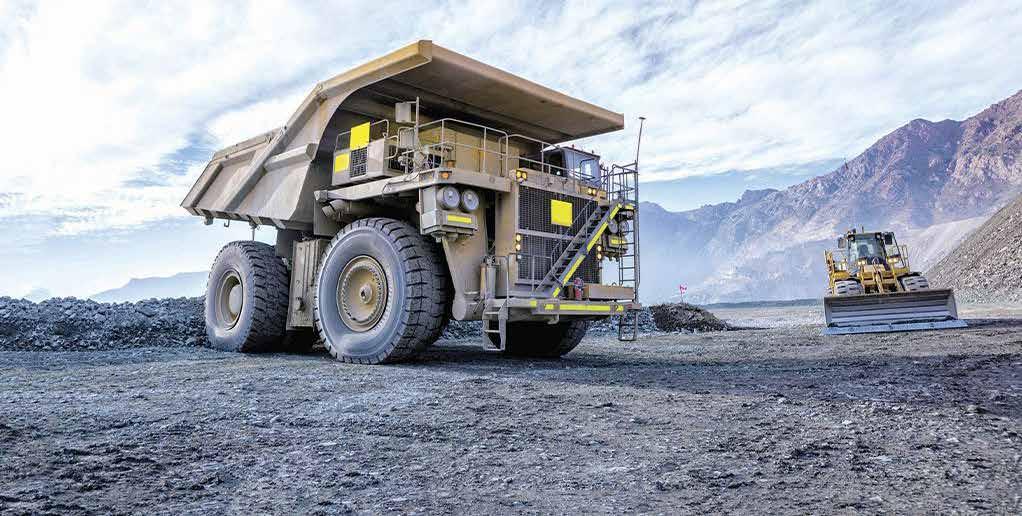
In the ever-evolving landscape of the mining industry, the integration of digital technologies has become imperative. However, the industry’s unique challenges make achieving seamless connectivity a formidable hurdle. As mining ventures delve deeper into this digital realm, the complexity of managing diverse data streams continues to escalate.
From extraction to distribution, telematics can manage every aspect of a company’s assets including lighting towers or generators, right through to heavy vehicles like trucks, buses, and state-of-the-art machinery in mines. Mining managers are focused on keeping assets and personnel safe, ensuring constant access to their full fleet by regularly scheduling maintenance, achieving their green goals by lowering their carbon footprint, lowering their operational costs, and improving their bottom line.
With a focus on key performance indicators (KPIs), MiX Telematics provides technology aimed at elevating mining capabilities, allowing mining companies to connect their business with a single, integrated platform that monitors equipment, assets, and fleet vehicles through vehicle and video telematics.
Our flagship solution, MiX Fleet Manager
Premium, comprises a sophisticated onboard computer that collects and transmits valuable vehicle and driver data. Driver behaviour, performance, fleet locations, engine diagnostics for preventative maintenance, and optimised route planning are tracked and monitored to aid a business in improving productivity & efficiency. The solution also tracks a range of connected metrics in real-time, improving asset utilisation while reducing operating expenses. This pre-emptive information gives site managers full visibility to all areas of their operations; equipping them with the data to continuously improve efficiency and performance.
Advancements in AI-powered technology have enabled the utilisation of video telematics in mining. The MiX Vision Al dashcam solution uses advanced machine learning to monitor risky driving behaviours and fatigue that could lead to fatal accidents. The camera solution, coupled with the tracking solution offer data and controls so that when incidents do occur, there is a trail of evidence to facilitate investigation, resolutions, and further corrective actions.
Moreover, MiX Telematics has embraced newer technologies to introduce modern solutions for data access and visualization. These include embedded dashboards, PowerBI
for self-service analytics, and MiX Integrate for raw data retrieval. MiX KPI Manager leverages powerful fleet data, offering customisable self-service analytics to track performance on key issues affecting (mining) fleet risk, safety, efficiency and sustainability.
The mining sector is also particularly sensitive to the impact that operations can have on the environment, and it’s our objective to demonstrate the efficacy of telematics to improve not only the health of employees on-site but to help companies reduce carbon emissions and achieve sustainability targets. “Additional benefits of telematics solutions in mining include optimised onsite communication, task and journey management, driver behaviour and performance monitoring, improved driver and employee safety, improved site, vehicle, and asset safety,” says Henry Smith, Fleets Sales Director at MiX Telematics Africa.
“From a MiX Telematics perspective, the solutions offered are refined and developed continuously to meet customer demand. As technology develops and becomes more accessible and affordable; the (mining) industry is realising the added value of telematics solutions” concludes Smith.
Mining Business Africa | March - April 2024 23 Fleet Management for Mining Operations
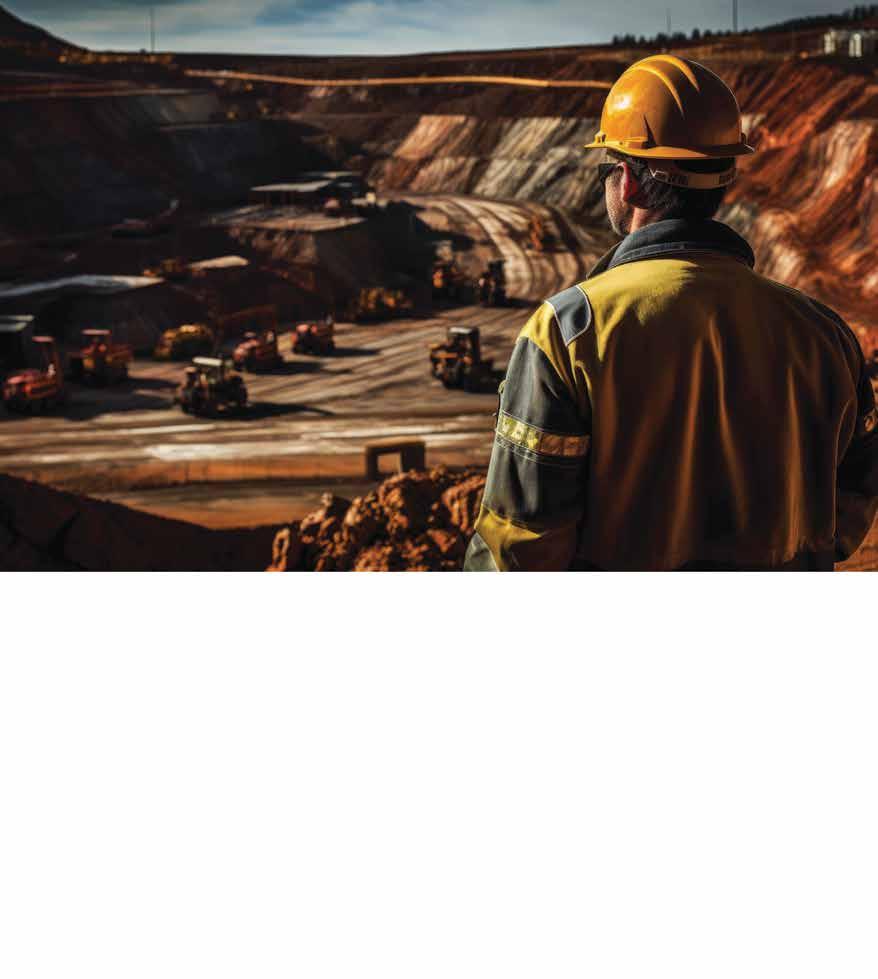



ESG Reporting for Mining Operations
Effective Reporting, Enhanced Performance
The surefire way through which African miners can be ESG compliant is by using reliable reporting tools

Acid mine drainage is one of the sticky issues that ESG reporting highlights
Currently, there are ongoing exploration and mine development projects to meet the demand for critical minerals to drive the green energy transition in Africa. One of the vital aspects central to their implementation is the integration of Environmental Social Governance (ESG) reporting compliance into core pillars and strategies of the respective players. Based on the mission statements of major listed mining companies active on the continent, it seems the companies involved are pulling all the stops to meet set targets.
However, one may ask: In light of these efforts, how effective are their well-intentioned efforts?
One of the biggest worries is the effectiveness of reporting techniques mining companies use. This is considering that the process entails collecting loads of data from different departments on various ESG aspects to meet the expectations of executives, the board of directors, investors, and the rating agencies.
Unfortunately, manually handling the maze of data required is complex and highly susceptible to error. This can result in mining companies falling short of expectations in ESG reporting. Thus, there is a solid business case for the adoption of new techniques to streamline data processing.
Solid business case
At the Investing in African Mining Indaba 2024 in Cape Town ESG was discussed at length, just
as the previous year’s event. At the end of the deliberations, one crucial aspect emerged: The solid business case for the use of effective ESG reporting tools to enhance performance.
Sabine Anderson, Principal Mining Engineer at SRK Consulting in Cardiff, United Kingdom, was a key member of the global SRK Consulting team at the Mining Indaba in Cape Town. Prominently, she highlighted a palpable shift from risk mitigation to value creation in ESG.
Cognisant of ESG’s value, corporates are integrating ESG considerations into decisionmaking and operations. Conspicuously, there is a recognition of the link between ESG performance and financial value.
Mining entrepreneur and SSC Group founder, Fred Arendse, touched on ESG as a key factor in accessing capital during a panel discussion at the Investing in African Mining Indaba 2023 (ESG Risks in the Mining Sector). “ESG has an impact on financing, whether through equity or debt. Globally, ESG has risen to the top of the regulatory agenda with the result that for financiers, ESG is unequivocally measured with defined environmental, social, sustainability, and governance systems of measurement resulting in the coined phrase, “sustainable finance.”
More scrutiny than ever
Small wonder, stakeholders are scrutinising mining companies more than ever. There is immense
pressure on companies to substantiate their performance in alignment with their commitments, Anderson pointed out.
Markedly, stakeholders no longer take ESG reports presented at face value. Appreciating more of its value, they are asking ‘tough’ questions.
Nomsa Mbere and fellow partners at Webber Wentzel, a law firm servicing clients in African mining, noted this in an article (Mining companies need to watch ESG-related risks in 2023). They said stakeholders demand transparency from mines and their holding companies, particularly those operating in conflict-sensitive or conflictaffected jurisdictions). Coming to mind is cobalt, a critical mineral for Lithium-Ion battery manufacture, mined in the DRC under atrocious conditions, resulting in large-scale environmental devastation.
Reliable report
Plainly, given the above scenarios, collecting and processing data has never been more important, as Arendse explained during the panel discussion in 2023: “The qualification and quantification of environmental, social and governance (ESG) risks and uncertainties across the mining lifecycle continue to gain more prominence and relevance in the business world.” For African mining operations, the importance of using reliable reporting tools cannot be overstressed.
26 Mining Business Africa |March - April 2024
• The Industry’s largest stock inventory to suit leading crusher brands
• Mining grade premium manganese and alloy crusher liners
• Expert Technical Support and Unrivalled Customer Satisfaction
• Global Reach - Supplying Worldwide


At CMS Cepcor ®, we are dedicated to providing you with high-quality crusher parts and service. With decades of experience, we have earned our reputation as the leading aftermarket supplier. Whether you operate a quarry or a mining operation, trust CMS Cepcor ® to keep your crushers running smoothly.
AUTHORISED CMS STOCKIST - AFRICAN CRUSHERS AND LINERS Contact - admin@africancrushers.co.za / +27 76 991 7438
THE CRUSHER PARTS SPECIALIST

Unlocking Capital and Mitigating Risks
The Team from Onyen demonstrated the capabilities of the firm’s AI-driven reporting system at the Investing in African Mining Indaba 2024. Encouraged by the rave reviews, they are confident the solution will shake up ESG reporting in African mining as players position themselves to participate in the green energy transition. Onyen is a Canadian-based and globally-focused provider of ESG reporting software to organisations in mining and other sectors.

Alot is said about the risk that Environmental, Social and Corporate governance (ESG) factors pose for miners. But perhaps most downplayed is that it represents an opportunity to create long-term value for stakeholders.
The reality is that sound Environment, Social, and Governance (ESG) reporting will be pivotal to the success of the exploration and development of critical minerals in Africa. Hence, it is paramount that organisations involved utilise tried and tested reporting tools.
Canadian-based and globally focused, Onyen informs players in African mining that its AIdriven reporting solution eliminates the burden of compiling relevant data related to vital factors in ESG inherent in traditional reporting methods.
Showcased at the Investing in African Mining Indaba for the second time (the first was in 2023), the solution could not have come at a more perfect time. ESG landscape is shifting to keep abreast of changes in the mining business.
Markedly, it has dawned on miners that a good ESG score is not just about ticking the compliance boxes. More importantly, it is about earning stakeholder trust and facilitating access to capital. Ernst & Young Africa’s strategy and transactions leader, Quintin Hobbs, pointed this out at the Investing in Mining Indaba 2024 during


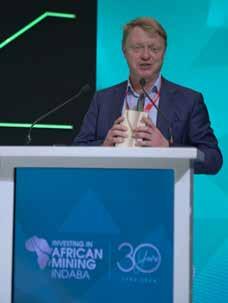
a presentation (Mining Risks and Opportunities Study).
Hobbs underlined the growing role of ESG credentials in attracting significant capital investment in new mining projects. “Major mining houses are reassessing business models to better address capital risks and opportunities. Companies’ continued capital discipline is “reaping rewards” for shareholders and broader stakeholders.“
Furthermore, Hobbs noted that organisations specialising in critical mineral projects have the edge.“The issue of capital raising is attracting more attention, with capital markets recognising the key role critical minerals will play in the energy transition.“
And so, to attract capital to their projects, exploration and mining companies must improve their ESG performance. The rule of thumb is: ‘the higher the ESG performance, the better the prospects of accessing capital’. It is not surprising that investors are finicky about forthright and impactful reporting.
Clearly, mining companies must utilise inventive solutions that not only fulfil compliance mandates but also facilitate capital acquisition and risk mitigation.
28 Mining Business Africa |March - April 2024

Filling the gap: Onyen’s AI-driven reporting system
Onyen’s AI-driven reporting system fills the gap in the need for forthright and impact reporting. Emerging as a ‘game-changing solution’, it provides a distinct advantage for mining companies to navigate the evolving ESG landscape.
Beyond compliance
The team involved in the software is confident that the reporting system will enable miners to achieve more than compliance, particularly in the following ways:
1. Cutting-Edge Artificial Intelligence: Revolutionising the Power of Data
Typically, ESG reporting entails compiling data from different departments located at various locations. Onyen’s ESG reporting is very convenient for performing this task.
Through utilising cutting-edge artificial intelligence, the core of Onyen’s ESG reporting has revolutionalised the task of processing and analysing vast amounts of data. In particular, by capitalising on the capabilities of AI, Onyen ensures comprehensive and accurate data collection.
In this way, organisations can generate meaningful insights into their ESG performance. Ultimately, this not only facilitates compliance with the latest standards but also proactively addresses emerging sustainability trends, perfectly positioning them for long-term success.
2. Access to Capital: A Strategic Imperative
As highlighted at the Investing in African Mining Indaba 2024, access to capital is intricately linked to a company’s ESG performance. Onyen’s AIdriven reporting system provides an advantage in this regard. Not only does it simplify the reporting process, but also amplifies the credibility of disclosed information. The ensuing heightened transparency resonates positively with investors. This increases the likelihood of attracting capital, as socially responsible investors, private equity firms, and other funding sources actively seek alignment with companies with best practices.
3. Risk Mitigation: A Proactive Approach to Sustainability
Mining companies are focused on mitigating risks associated with climate change, biodiversity loss, workforce safety, and corporate governance. In Onyen’s AI-driven reporting system, they have

a suitable tool.
By employing advanced analytics and predictive modelling, Onyen identifies potential risks before they escalate and become too costly to manage. This enables companies to implement targeted mitigation strategies.
On the whole, the proactive approach safeguards against financial losses. In addition, through demonstrating a commitment to building a responsible and resilient business, the system enhances the organisation’s reputation.
4. Enhanced Compliance: Navigating Regulations Confidently
Staying compliant is crucial in the rapidly transforming ESG domain. Accordingly, Onyen’s ESG reporting system adapts seamlessly to evolving regulations. Thus, ensuring organisations remain compliant without overburdening resources.
Thanks to its flexibility and scalability, particularly, Onyen particularly facilitates internal gap analysis. As a result, it empowers businesses to navigate the complex regulatory landscape confidently by avoiding penalties and reputational damage associated with non-compliance.
5. Stakeholder Engagement: Building Trust Through Transparent Communication
In mining operations, effective ESG reporting transcends meeting regulatory mandates. It has
more to do with building trust with stakeholders. Handily, Onyen’s AI-driven system facilitates clear and transparent communication of a miner’s sustainability initiatives, performance, and long-term goals. This enhanced reporting fosters stronger relationships with customers, employees, investors, governments, and the broader community, aligning corporate values with stakeholder expectations.
6. Seamless Integration: Efficiency without Disruption
Onyen acknowledges the importance of seamlessly integrating ESG reporting into existing business processes. That is why the AIdriven system is designed for ease of use and compatibility with various enterprise systems. Due to this feature, it minimises disruption to day-to-day operations while maximising efficiency in data collection and reporting. By and large, organisations can leverage the power of Onyen without overhauling their IT infrastructure, ensuring a smooth transition to a more sustainable and responsible business model.
Strategic asset
All told, demonstrably, the Onyen ESG reporting system is not just a compliance tool. It is a strategic asset propelling miners towards financial success, risk mitigation, and stakeholder trust. By leveraging advanced artificial intelligence, Onyen empowers businesses to confidently navigate the changing ESG landscape by gaining a competitive edge in accessing capital, building resilient corporate cultures, and meeting compliance obligations. More importantly, in a transitional environment towards a more decarbonised and circular global economy, Onyen stands as a beacon of innovation, guiding companies towards a prosperous future.
The team at ONYEN are ready to address the needs of potential clients in African mining regarding ESG reporting. https://www.onyen.com/ Onyen
For a demo of the Onyen ESG reporting system contact:
ON M5X1C7
M: +1 (647) 503-3433
sales@onyen.com
Sales Team
Canadian Place
- 100 King St. W.
First
5700
Toronto,
Advertorial
Mining Business Africa | March - April 2024 29
Drones for GPS-denied Underground Mining Areas
All-weather Drone for Inaccessible Areas Underground
For all the hype, GPS-enabled drones cannot operate in some nooks and crannies of underground mining. This is where the Elios 3, produced by Swiss drone company Flyability, fills the gap. Equipped with the high-resolution Ouster OS0-128 Rev 7 LiDAR sensor, in combination with the world’s leading FARO Connect SLAM algorithm, Elios 3 creates incredibly accurate 3D maps

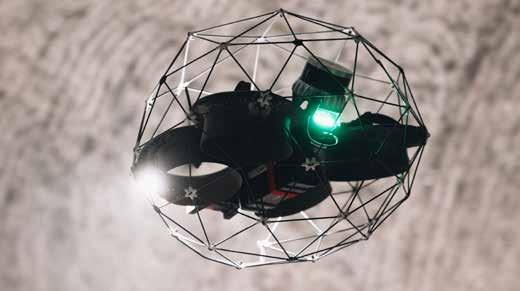
Drones are changing the way underground and overground mines digitize their sites. With the ability to get immediate aerial perspectives, machine inspections, and 3D modeling, drones are paving the way for innovation. Although the mining industry can be slow to adopt new technologies, specially designed drones are already in use across the globe.
The Elios 3
The Elios 3, produced by Swiss drone company Flyability, is one such specialized drone. The Elios 3 has a unique structure that uses a combination of hardware and firmware to cope with extreme conditions, including underground mines.
The drone can fly in GPS-denied areas, not relying on GPS for localisation. Instead, it uses a simultaneous localisation and mapping (SLAM) algorithm to map and locate itself in its environment by creating a live 3D map. Furthermore, the Elios 3 has a protective, collision-tolerant cage as well as firmware that can recognise and recover from collisions to help it cope with impact during flight.
Drone-based LiDAR with Surveying Payload
Comprehensive data is key to supporting operational decisions. Yet many hazardous environments are beyond the reach of existing data capture technologies.
Conveniently, Flyability’s Surveying Payload turns the Elios 3 into a flying mobile scanner that can fit through openings as small as 50x50cm, and create high-resolution scans beyond line of sight. In this way, it allows industry professionals to provide rapid insights that are not accessible with traditional tools or other UAV technologies.
The high-resolution Ouster OS0-128 Rev 7 LiDAR sensor, in combination with the world’s leading FARO Connect SLAM algorithm, creates incredibly accurate 3D maps and digital twins of the most inaccessible spaces with centimeter precision - for accurate measurements and greater insights.
1. Centimetre accurate maps
The Elios 3’s Surveying Payload has higher accuracy and precision than its standard LiDAR payload. It gathers over 1 million points per second, with greater range and clarity in its
results.
As part of testing, Flyability found that 95% of points captured are accurate to within 12 mm. This centimeter accuracy means the drone can produce near-identical digital twins of reality. In mines, this empowers clear visualization of the conditions of an area - whether for calculating backfill volumes, monitoring progress or even investigating old workings remotely.
2. More robust
The new LiDAR capabilities are also more robust. The Surveying Payload comes with the software FARO Connect. This software has tailored presets that enable it to process LiDAR point clouds from the Elios 3 as efficiently as possible. Between this software and the drone’s enhanced capabilities, the Elios 3 now has greater tolerance for environments with higher symmetry (such as tunnels) which can challenge laser scanners. Testing of the Elios 3’s results identified drift at just 1% - which is lower than previous iterations of the Elios 3’s laser scanner and matches the requirements for many mapping requirements for mining projects.
30 Mining Business Africa |March - April 2024
3. Flexible, simple to use, and cost-effective
The Elios 3 presents the ideal tool to add to mining workflows, able to provide high-quality data more safely. It is flexible, simple to use, and cost-effective.
Thanks to its modular design, mine engineers can benefit from the capabilities of its Surveying Payload which includes enhanced range, a denser point cloud, and specialised software that can automatically georeference models and merge multiple point clouds.
4. Unlocking a range of applications
By and large, the applications of the Elios 3 in mines are immense - from standard operations such as monitoring stockpiles and mapping stopes or ore passes, to more challenging projects including localising hang-ups, exploring falls-of-ground, and measuring shotcrete thickness, the capabilities of the Elios 3 and its Surveying Payload are near limitless. It can also be deployed for emergency response and crisis management, providing key situational awareness as fast as possible when decision-making is under pressure.
5. Improvements in safety and efficiency
On the whole, drones such as the Elios 3 empower significant improvements in terms of safety and efficiency. The drone can be used to scout unsafe environments and gather accurate information for decision-making. It can also work quickly, scanning areas in minutes and cutting any downtime.
In a nutshell, the benefits of the Elios 3 and its mapping payload are clear: higher accuracy, greater access and reduced risks. That’s why the all-weather drone is perfect for underground mining applications.
The Elios 3 in Action Undersea
The Elios 3 Surveying Payload is already in use at a mine at Boulby in the UK. With part of the mine extending underneath the sea and old workings dating back to 1968, the Elios 3 is making management of the site and area safer and easier.
In 2023, the Elios 3 was used to access a no-go area that needed to be inspected. The tunnel in question was 340 meters long, and in the past, required 4 flights with the Elios 3 to cover the entire area which took 20 minutes in total. This included scanning beyond the visual line of sight, adding to the complexity of the flights which can challenge the connection between the remote controller and the drone. On the surface, the scans would be registered and post-processed to provide a new point cloud.

Streamline your mining operations with visuals and metric data from out-of-reach places
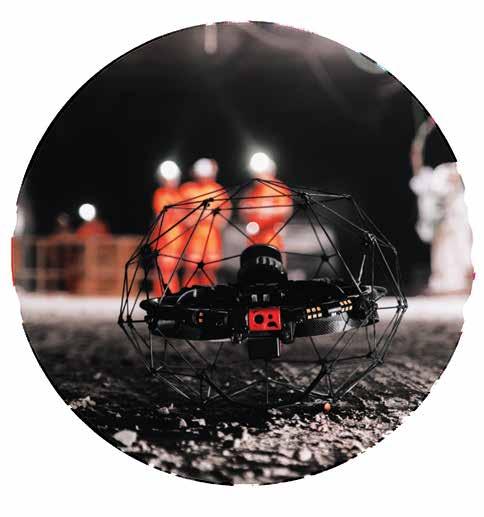
With the new Surveying Payload, an Elios 3 pilot completed a scan covering the area previously surveyed in just 1 flight, halving the flight time and preserving battery life. Furthermore, due to the increased range with the new payload, post-processing time was significantly reduced as multiple scans did not need to be merged. Thanks to using the Elios 3 and its Surveying Payload, it was possible to complete a scan in under 10 minutes, cutting flight time in half and not causing any prolonged downtime while the drone was in flight.
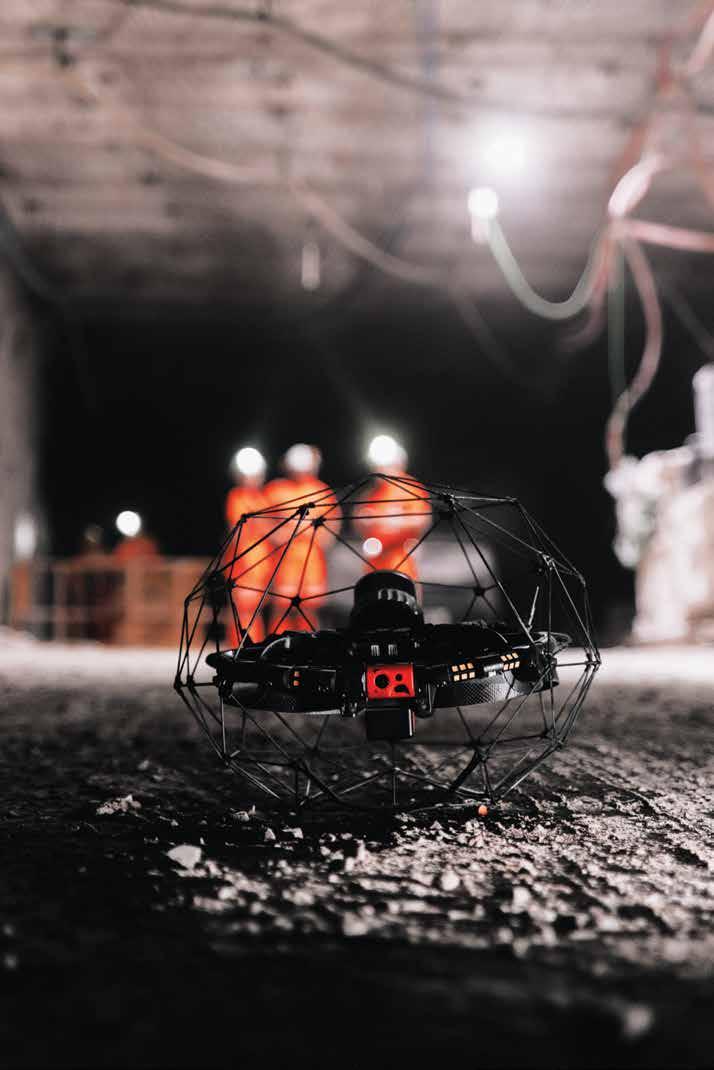
Mining Business Africa | March - April 2024 31
to
Scan the QR to schedule a call www.flyability.com/mining C M Y CM MY CY CMY K flyability Hpfc option 1.pdf 1 27/02/2024 2:09:21 PM
Want
discuss your mining inspections?
AI Data Driven Reporting and Enhanced Plant Optimisation
With real-time monitoring and AI capabilities, TalbotAnalytics eliminates guesswork from the management of water treatment plants in mining.

To enhance water management strategies, real-time, accessible data must be made available to mining companies
Water security has become a paramount concern, not only for mines across southern Africa but on a global scale, with profound implications for operational viability, regulatory compliance, and community relations.
The multifaceted issue of water secuirty is influenced by various factors, spanning from global trends to local catchment-specific conditions. Key determinants of water security include primary water availability, which is increasingly impacted by climate change and escalating demand driven by population and industrial growth. Additionally, the integrity of water infrastructure has emerged as a challenge
contributing to the overarching “water crisis”. Political agendas, such as dam construction and transfer schemes, further complicate the landscape.
In South Africa, financial considerations, including water price inflation, at an average of 10% annually for the next three years, and rising costs of infrastructure operation, maintenance, refurbishment, and replacement, exacerbate the challenges faced by the mining sector. This sector is confronted with an abundance of obstacles. Addressing these challenges necessitates innovative water managment strategies incorporating AI and software solutions.

Data
Conventional water management techniques
Water has long been undervalued, resulting in a lack of systematic measurement and tracking in the mining industry, a trend that began to shift with energy in the mid-2000s but is only now emerging in water management. Limited data exists, primarily confined to incoming volume and water flow metrics, leaving a substantial gap in understanding water usage and trends. Even when data is available, accessibility remains a significant challenge, hindering effective water management efforts.
Thus, to enhance water management strategies, real-time, accessible data must be made available to mining companies. This allows for the immediate detection of water losses and abnormal water usage per unit of product. It also facilitates the presentation of the potential costs associated with disruptions due to water unavailability, as well as the financial benefits of implementing water savings and wastewater treatment solutions.
In addition, it is imperative to predict future periods of water deficit by analyzing future water requirements alongside historical water usage patterns. This involves identifying and evaluating risks using advanced monitoring systems, such smart metering data-driven approaches, which encompasses factors such as water availability, quality, cost, and competing demands from various users.
The solution. TalbotAnalytics.
From having spent over 15 years modelling water security for clients across Africa, TalbotAnalytics was developed specifically as a robust water management solution for mines and industries. It simplifies collaboration and data sharing with process specialists, consultants and strategic partners, by using Machine learning and AI.
Data is collected in real-time from agnostic smart sensors installed on water-related equipment within the mining operations. These sensors continuously monitor various parameters, such as water volume and a borad range ofquality parameters, providing a live feed of crucial operational data.
This collected data is then transmitted to a cloud-based storage system, enabling remote access and analysis. In some setups, a Programmable Logic Controller (PLC) may first aggregate and pre-process the data before it’s
32 Mining Business Africa |March - April 2024 Analytics Software for Water Treatment Plants in Mining
is collected in real-time from agnostic smart sensors installed on water-related equipment within the mining operations

sent to the cloud, optimizing the data for further analysis.
Once in the cloud, sophisticated algorithms and data processing tools analyze the raw data. This analysis transforms the raw sensor readings into actionable insights, identifying patterns, trends, and potential anomalies within the operations. This process is crucial for converting vast amounts of raw data into meaningful information that can drive decisionmaking.
The processed data is then integrated into a Software as a Service (SaaS) product to facilitate the visualization and interpretation
How TalbotAnalytics has saved the mining sector millions.
Mining companies have historically spent large sums on the purchase of water from Water Service Providers (Water boards or Municipalities) as well as the management of contaminated or excess water. However, in water positive areas mines now realise that the water they were once pumping from underground, to keep the mine workings dry, and discharging at the surface, has immense value.
By installing a water recovery plant and ensuring optimal plant performance, treated water that was previously discharged to a potable level, can now save the mine millions per month and at the same time reduce their demand on the municipal system. The treated water is now 100% compliant and available for other purposes/users.
Each mine presents with its own unique challenges for which Talbot has devised specific approaches and solutions. Where TalbotAnalytics is deployed, there are consistently vast improvements in the optimisation of water use and water treatment.
A key challenge to mine water treatment is that both surface and ground water surrounding and within the mine may be exposed to a variety of contaminants; from the geology itself, mining techniques, machinery, and even from cooling systems.
Water pumped from underground is clarified at source to limit the impact of TSS contamination on mine equipment (pumps & pump impellers) and to limit it’s transfer to the surface. However, due to the limitations of
working kilometers below the earths surface there is significant variabilty in the effectiveness of this first stage of treament as dosing of polymers is often inconsistent. This can have a large impact on the water treatment operations at the surface.
Through live tracking of key parameters, such as pH, electrical conductivity, turbidity, colour, and temperature, TalbotAnalytics ensures the stabilty of the treatment plant by providing real time data, enabling immediate decisions to be made.
Pretreatment and operational cleaning regimes are customised specifically for each mine’s raw water. Other key performance indicators which are monitored consistently include membrane performance, daily water production, water recovery and losses per process. With real time data and TA the agility necessary for efficient production is delivered.
Tracking anything enables you to better manage it and derive value from it. Through our software as a service platform, TalbotAnalytics, integrates AI, the best of human expertise, and agnostic smart-technology to ensure mining companies optimise their product recovery, minimise environmental impact, and enhance regulatory compliance.

With the ability of accessing realtime data and predictive analytics, our software enables proactive decisionmaking, facilitating essential cost savings and operational efficiencies while safeguarding water resources.
Mining Business Africa | March - April 2024 33
Transformer Chemistry Services for Mining Operations
Powering up Productivity in Mines with WearCheck
“Our transformer team is standing by to partner with mines to power up their mining operation for a brighter, more sustainable future.”
The heart of any mine beats to the rhythm of a constant power flow. And at the core of this flow lies the unassuming hero –the transformer. These silent giants tirelessly convert voltage levels, ensuring efficient electricity distribution across sprawling mine sites. But just like any unsung hero, transformers are susceptible to fatigue and failure. When they falter, the consequences can be catastrophic –production grinds to a halt, costs skyrocket, and safety concerns arise.
This is where WearCheck’s transformer oil testing services emerge as the knight in shining armour. Tailored specifically for the unique challenges of the mining industry, these services offer a comprehensive suite of solutions that go beyond mere monitoring. WearCheck doesn’t just identify problems; the company predicts them, empowering mining operations to manage transformer proactively health and maximise productivity.
The mining landscape – where transformers face unique threats
‘Mining environments are notorious for their harshness,’ says WearCheck’s transformer division manager, Gert Nel. ‘Dust, moisture, and extreme temperature fluctuations combine to create a battleground for transformer oil. These elements accelerate oil degradation, leading to a cascade of issues,’ Nel explains. ‘These include:
• Increased acidity: this weakens the oil’s insulating properties, increasing the risk of arcing and short circuits, potentially igniting dangerous fires.
• Dissolved gases: faulty equipment or overheating can produce telltale gases like hydrogen and CO2, hinting at internal faults waiting to happen.
• Sludge and metal particles: wear and tear generate microscopic debris that contaminates the oil, further accelerating insulation breakdown.’
Nel warns that if these issues are left unchecked, they can snowball into catastrophic transformer failures, with consequences that echo across the entire operation, such as:
• Production stoppages: a single transformer failure can bring an entire mine to a standstill, resulting in lost revenue and productivity, impacting every facet of the operation.
• Safety hazards: transformer fires pose significant safety risks to personnel and

Gert Nel WearCheck divisional mger transformers - author pic
equipment, making early detection and mitigation crucial.
• High repair costs: replacing or repairing transformers can be incredibly expensive, putting a significant strain on budgets.
Instead of waiting for disaster to strike, WearCheck’s transformer oil testing services team takes a proactive approach, acting as a shield against potential failure. Nel outlines the company’s multi-faceted approach:
1. Regular Oil Sampling and Advanced Analysis
• Trained sample-takers ensure timely and accurate oil sample collection at prescribed intervals. WearCheck offers on-site sampling, alternatively, a member of the mine’s maintenance crew, who is trained in sampling, can take the sample.
• The samples undergo rigorous analysis in WearCheck’s accredited laboratories, utilising cutting-edge techniques, such as:
• Furanic testing (HPLC instrument): assesses levels of furans, which are organic compounds formed during oil degradation, serving as indicators of transformer insulation deterioration. This diagnostic method detects furan derivatives through gas chromatography, revealing the oil’s condition and predicting potential
transformer faults. By quantifying furans, technicians gauge the extent of thermal and electrical stress on insulation, crucial for pre-emptive maintenance scheduling. Elevated furan levels signify increased risk of transformer malfunction, prompting corrective action to prevent failures. Furanic testing thus plays a vital role in ensuring transformer reliability, extending equipment lifespan, and averting costly downtime in electrical power systems.
• Dissolved Gas Analysis (DGA): detects even minute traces of dissolved gasses, acting as early warning signs of internal faults and overheating.
• Physical and chemical tests: measure key parameters like viscosity, acidity, and moisture content, providing a holistic picture of oil health.
2. Detailed Reports and Trend Analysis
• Results are presented in clear, concise reports tailored to the mine’s specific needs, offering actionable insights that go beyond raw data.
• By tracking oil condition over time, trend analysis empowers the WearCheck team to identify subtle changes and predict potential problems before they escalate.
3. Expert Interpretation and Recommendations
• WearCheck’s team of seasoned transformer oil specialists don’t just analyse data; they translate it into actionable insights.
• They conduct root cause analysis of any identified issues, pinpointing the exact source of the problem.
• They provide clear recommendations for corrective actions, like oil filtration, additional testing, or even equipment adjustments.
• Additionally, they offer predictive maintenance advice, empowering the mine’s maintenance team to prevent future failures before they even have a chance to occur.
4. Customised Service Packages
WearCheck understands that no two mines are alike. The company offers a variety of service packages to cater to individual
34 Mining Business Africa |March - April 2024
requirements, ensuring that each mining operation gets the level of coverage and support they need, without unnecessary expense.
5. On-site Training and Support
Empowering the maintenance team is key. WearCheck offers training programmes designed to equip mining maintenance personnel with the knowledge to understand transformer oil analysis reports and make informed maintenance decisions. Additionally, their ongoing support ensures the efficient implementation of their recommendations, keeping transformers operating at peak performance.
The Payoff: Powering Up Productivity and Profitability
The benefits of WearCheck’s transformer monitoring services go far beyond merely avoiding downtime. They empower mining operations to:
• Reduce Downtime: by proactively identifying and addressing potential issues, mines can prevent unplanned outages, ensuring smooth and uninterrupted operations.
• Extend Equipment Life: timely intervention and optimised maintenance practices significantly extend the lifespan of transformers, saving the mines money on replacements.
• Improve Operational Efficiency: reliable
transformers translate to a consistent power supply, minimising disruptions and optimising mining processes for maximum efficiency.
• Enhanced Safety: early detection of potential hazards like overheating and incipient faults prevents transformer fires and accidents, safeguarding minebased personnel and equipment.
• Cost Savings: the combined impact of reduced downtime, extended equipment life, and optimised operations translates to significant cost savings. By preventing failures, WearCheck helps mines to avoid hefty repair costs and lost production revenue, optimising the bottom line.
• Transparency and Trust: WearCheck operates with complete transparency, providing detailed reports and clear explanations of their findings and recommendations. This fosters trust and collaboration, empowering mines to make informed decisions about transformer health management.
• Sustainable Operations: by ensuring efficient power usage and minimising transformer-related downtime, WearCheck contributes to sustainability goals. By optimising equipment life and reducing waste, mining operations can

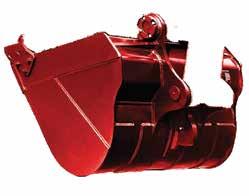

minimise their environmental footprint and operate more responsibly.
Nel and his team understand that mining operations face inherent risks and uncertainties. When it comes to transformers, however, mines don’t have to operate in the dark. WearCheck’s transformer oil testing services offer peace of mind by providing predictability, control and confidence.
Nel reaffirms that these services are not just an expense; they are an investment in the future of the mine, and the greater environment in which it operates. “By ensuring reliable power, minimising downtime, extending equipment life, and optimising operations, a mine can gain a competitive edge and maximise profitability,” he said.
“In today’s competitive mining landscape, reliable power is not a luxury; it’s a necessity. WearCheck offers a powerful solution, empowering mines to operate with confidence, optimise productivity, and achieve full potential. Our transformer team is standing by to partner with mines to power up their mining operation for a brighter, more sustainable future.”
For further information, visit www.wearcheck. co.za, email marketing@wearcheck.co.za or call WearCheck’s head office on +27 (31) 7005460.
WearCheck, Africa's leading condi�on monitoring company, is commi�ed to serving the mining industry with its range of sophis�cated analy�cal techniques.
Our specialist oil, coolant and fuel tes�ng programmes allow customers to reduce maintenance costs, avoid unexpected mechanical failures and ul�mately reduce unscheduled down�me. Unlock Machine Reliability!
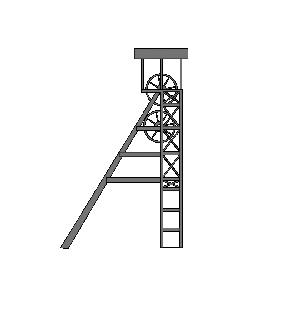

Mining Business Africa | March - April 2024 35
Branches Botswana DRC Ghana Mozambique Namibia Uganda Zambia Zimbabwe +267 311 6829 +260 977 622 287 +233 54 431 6512 +258 85 792 7933 +264 81 141 7205 +256 78 529 6994 +260 212 210 161 +263 24 244 6369 + 27 31 700 5460 marke�ng@wearcheck.co.za www.wearcheck.co.za South Africa (Head Office) Condi�on monitoring is KEY to mining produc�on Tes�ng and Analysis | Lubricant-Enabled Reliability | Asset Reliability Care C M Y CM MY CY CMY K WCK Mining Business Africa 180x130 copy.pdf 1 2023/05/17 10:40:14
Circular Polarised Antennas for Underground and Tunnels Deployment
Frequency Stability and Reliability in Underground Communications
Circular Polarised Antennas, manufactured by Poynting Antennas, have excelled in demanding conditions in underground mining conditions worldwide, offsetting performance problems encountered with Linearly Polarised Antennas. Through its new Markets and Special Projects division, the company is introducing their stable and reliable Antennas to new customers in African mining.
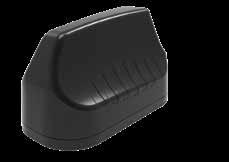



As mining operations increasingly migrate underground in search of ore, effective and reliable communication is one of the factors central to high productivity and enhanced safety. Cognisant of this, Poynting Antennas, a leading provider of Circular Polarised Antennas, is urging mining companies to make informed decisions when selecting communication tools, not least Antennas.
Circular Polarised Or Linearly Polarised Antennas?
Concerning Antennas for underground environments, mining companies have two options available, Circular Polarised and Linearly Polarised. In the rugged and unpredictable underground tunnels, a more suitable product would be circular polarised Antennas, states Pieter Prinsloo, New Markets and Special Projects Manager at Poynting Antennas.
Prinsloo demonstrates the principle that gives Circularly Polarised Antennas the edge: “Rotating’ the electromagnetic wave (Radio Wave) ensures that the entire cross-section of the Tunnel is ‘covered’ by the Radio Signal. Using ‘Left-Hand- and Right-Hand’ Polarised Antennas ensures that more of the ‘reflections’ are ‘captured’, providing the Receiver with a much better Signal-to-Noise Ratio.”
In a nutshell, with circular Antennas, the ‘rotating’ Radio Wave (i) and the ability to capture more reflections of these Radio (Electro-magnetic) Waves (ii) results in high performance. Thus, far longer distances can be covered at much higher data rates using Radio Signals underground than using linearly polarised Antennas.
Poynting Circular Polarised Antennas
For clients in need of stability and reliability, Poynting Circular Antennas are more effective by a country mile than linearly polarised, Prinsloo affirms . This is based on evidence of the immense benefits the Antennas bring to communication.
Relevant features
Equipped with relevant features, Poynting Circular Polarised Antennas are a perfect fit
for conditions in underground mines. Uniquely, these include the following:
1. Wide range of frequencies
Relating to frequencies, the Poynting Circular Polarised Antennas consist of:
• Circular Polarised Antennas for the Wi-Fi 2,4GHz – 2,5GHz as well as the 5GHz – 6GHz Carrier Frequencies. Recent updates have increased the latter to extend to 7.2GHz.
• Circular Polarised Antennas for the LTE, 4G and 5G Frequencies for Mobile Network Operators from 698MHz to 7,2GHz. The Antenna range for the LTE (including private LTE), 4G and 5G has recently undergone a redesign. As a result, currently Poynting can offer a Circular Polarised Antenna range with excellent frequency response from 1700MHz to 7,2GHz. Designs are under way to increase the range from 617MHz to 7,2GHz in a single Antenna.
Generally, Poynting Circular Polarised Antennas cover all the Frequencies used by Wi-Fi and/ or LTE, 4G, and 5G deployment used to communicate Radio Frequency Signals in underground mining Tunnels.
2. Circular deployment
All Poynting Circular Antennas come in both ‘Left-Hand- and Right-Hand’ Circular Polarised Antennas. The above Antennas include both 2x2 MIMO as well as 4x4 MIMO deployment with a Bracket specifically designed to house either 2x Uni-Directional / Bi-Directional Antennas or 4x Uni-Directional / Bi-Directional Antennas.
3. High ingress protection
What’s more, Circular Polarised Antenna elements are all housed in a Radome, which provides an Ingress Protection (IP65) rating. IP65 provides the highest level of dust ingress protection, as well as ‘low pressure’ water jet protection, equivalent to ‘heavy rain’.
4. ‘Tapered Helical’ design
The Poynting Circular Polarised Antennas have a unique patented ‘Tapered Helical’ design.
36 Mining Business Africa |March - April 2024
This results in unique performance benefits, as demonstrated in several underground deployments in Mine Tunnels worldwide.
5. Intrinsically Safe
Intrinsic safety refers to a design principle for electrical equipment used in hazardous locations, where there is a risk of explosive atmospheres such as the ‘carbon dust‘ in Coal Mine Tunnels or potential Gas Leaks in Vehicle / Service Tunnels. An intrinsically safe (IS) Antenna is designed to minimize the risk of ignition in such environments.
Poynting also manufactures Antennas that are Intrinsically Safe that are encapsulated and covered with a conductive coating which is grounded to prevent any electrical components from coming into contact with the potentially explosive atmosphere. This helps contain any potential ignition source.
Glowing Customer Feedback
To date, Prinsloo says the Poynting team is delighted by glowing customer feedback on their experience of using Poynting’s HELI Circular Polarized Antennas. The latest deployments
of the HELI Circular Polarized Antennas have resulted in huge cost savings, with reference to the number of Antennas needed to achieve reliable, fast underground Radio communication. Currently the growing number of customers that have benefitted from these HELI Antennas are from countries in South America, North America including Canada, Europe, Africa including South Africa, and Australia.
Precisely, the details indicating that HELI Circular Polarized Antennas have become an industry favourite are in the numbers supplied, Prinsloo demonstrates. “Just our Circular Polarised Antennas for the Wi-Fi Frequencies; 2,4GHz – 5GHz and 5GHZ to 6GHz have sold more than 6000 Antennas worldwide.”
Developments on the cards
Poynting’s Research and Development (R&D) team thrive on continuous product development to improve the end-user experience of its popular Antenna range. On the cards are two developments.
As aforementioned, Poynting Antennas is enhancing the capabilities of its Circular Polarised Antennas to cover an even larger
frequency spans, in particular, the lower frequencies used by mobile operators.
The company will also introduce more versatile mounting options, such as the ability to direct Antennas along the route followed by underground vehicles in circular decline. These products will be launched soon.
New division for new markets
Expansion in the African region has always been high on Poynting’s priority list. The creation of a new Division responsible for New Markets and Special Projects underlines this. The company is now well-equipped to address specific Circular Polarized Antenna needs of clients in mining. “Clients are welcome to engage us to discuss their Antenna requirements that may not already be covered by our extensive Antenna range,” Prinsloo points out, assuring that in collaborating with Poynting, prospective clients should be assured of a seasoned player. Poynting has been manufacturing Circular Polarised Antennas since 1996 and specifically for the Mining Industry for more than fifteen years.



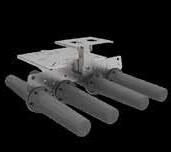


Mining Business Africa | March - April 2024 37
BI-DIRECTIONAL, WIFI ANTENNAS HELI-42 HELI-31 POOR UNDERGROUND COMMUNICATION? USE THE POYNTING CIRCULAR POLARISED ANTENNAS WITH YOUR RADIO EQUIPMENT & HAVE FASTER, MORE RELIABLE UNDERGROUND COMMUNICATION OVER LONGER DISTANCES. MAKING CONNECTIVITY HAPPEN TEL: + 12 657 0050 | EMAIL: info@intetoconnect.co.za | WEBSITE: www.intetoconnect.co.za C M Y CM MY CY CMY K
Circular Polarised Antennas for Underground and Tunnels Deployment
HELI-42
The HELI-42 forms part of the Mini-HELI Antenna series.
• These Antennas are ideal for mining tunnels where IoT/M2M connectivity is deployed and can also be used for coverage into the stopes.
• The HELI-42 is a dual-band 2.4 GHz and 5 GHz Wi-Fi Antenna, radiating in both directions (i.e., bi-directional).
• This makes them ideal for the coverage of both Wi-Fi bands in mining and other type of tunnels.
• These Antennas are typically used for the deployment of IoT within the tunnel to provide telemetry and mining automation.
• The dual-band Wi-Fi connection propagates around tunnel bends in a Non-Line of Sight scenario and provides immunity to many Wi-Fi signal disrupting objects such as trains and drilling machinery which appear to obscure the tunnel.
HELI-40
The HELI-40 adds to Poynting current HELI Antenna range for mining and tunnelling deployments.
• The HELI-40 is a dual-band 2.4 GHz and 5 GHz Wi-Fi Antenna, radiating in
Product reference table
both directions (i.e. bi-directional).
• This makes the Antenna ideal for coverage of both Wi-Fi bands in mining and other type of tunnels.
• The HELI-40 was specifically designed for vehicle/equipment mounting, making it ideal for deployment within the tunnel to provide telemetry and mining automation.
• The Antenna is 2x2 MIMO and provide optimal decorrelation within a MIMO deployment.
• The polarisation diversity and frequency diversity of the Antenna enhances MIMO performance and RF reliability within a mining tunnel.
• The circular polarisation allows the dual-band Wi-Fi frequencies to propagate around tunnel bends in a non-line of sight scenario.
• This provides improved performance with enhanced link stability and reliability.
MIMO-4-19
The MIMO-4-19 is a 9-in-1 high performance, multi frequency Antenna within a single housing.
• The Antenna provides four cellular, four Wi-Fi and a GPS/GLONASS Antenna.
• The four cellular MIMO Antennas
offer wideband coverage from 617 to 6000 MHz, covering contemporary LTE/4G and 5G bands for future proof implementation.
• The ultra-wideband performance of the cellular Antennas allows it to be used across different operators and technologies and is ready for future cellular technologies up to 6 GHz for 5G applications, as well as Wi-Fi application from 5 to 6 GHz.
• The MIMO-4-19 exceeds the performance of most competitors due to the attention to the design of this highperformance Antenna.
• The radiation patterns of all radiating elements provide an excellent balance between omni-directionality, pattern diversity and good radiation abilities at the desired elevation.
• This is an important criterion for the transportation and marine market, which the Antenna was specifically designed for.
• Main applications are for commercial/ industrial vehicles, marine, M2M and other IoT systems using a wide range of radio technologies, while remaining futureproof over the wide frequency band.
Below is an easy reference table listing our most popular Circular Polarised Antennas for underground and tunnels deployment. Please contact the Team at Poynting for your specific needs relating to Circular Polarised Frequency deployment.

38 Mining Business Africa |March - April 2024
Shift Management
Introducing the digital shift-boss logbook from Mineware Consulting
“The new digital shift boss logbook, launched by Mineware Consulting, is an advanced, technology-driven version of the traditional paper-based logbook, offering several data-driven advantages.”
Ashift-boss plays a crucial role in overseeing the operations of a mine during a specific shift. Their primary responsibility is to ensure the safety, efficiency, and productivity of the mine. This involves ensuring compliance with safety regulations and protocols through regular inspections and monitoring, managing the mining crew by assigning tasks and supporting workers, and overseeing day-to-day operations such as planning, scheduling, and adjusting tasks to meet production targets.
An effective shift-boss is adept at problemsolving in order to address issues such as equipment malfunctions or operational delays and serves as the key point of contact between the mining crew and higher management, communicating significant developments and challenges.
Additionally, the shift-boss is responsible for maintaining accurate records of shift activities, including worker attendance, production levels, and any incidents.
The shift-boss logbook
A shift boss logbook, typically a paper record, is a critical record-keeping tool used by a shift boss or mine supervisor. The shift-boss logbook is a legally required and essential tool in mining operations. Its primary purpose is to ensure legal compliance, uphold quality mining practices, and guarantee adherence to planned work.
The logbook typically includes information such as the number of workers on duty, equipment used, work progress, any safety incidents or hazards encountered, and compliance with mining regulations and procedures.
The logbook is instrumental in managing resources effectively, including skills, materials, and equipment, and ensures that all equipment is maintained and operated according to acceptable standards. This logbook aids the Shift-boss in fulfilling their legal responsibilities and overseeing daily operations efficiently.

Digital shift-boss logbook
The new digital shift boss logbook, launched by Mineware Consulting, is an advanced, technologydriven version of the traditional paper-based logbook, offering several data-driven advantages.
1. Real-Time Data Entry and Access: Digital logbooks allow for real-time recording and retrieval of information. This immediacy means that data about a shift’s activities, safety incidents, and production metrics are always up-to-date and accessible to relevant personnel, even those not on-site.
2. Enhanced Data Management: Unlike paper logbooks, digital versions can efficiently handle large volumes of data. They can be structured to capture specific types of data systematically, making it easier to organize and analyze information.
3. Improved Communication and Collaboration: Digital logbooks facilitate better communication among shift bosses, mine managers, and other stakeholders. Information can be shared quickly and efficiently, enhancing collaboration and decision-making processes.
4. Automated Reporting and Analysis: These logbooks can be integrated with other mining management systems, allowing for
automated reporting and analysis. This integration can provide insights into trends, operational efficiencies, and areas needing improvement.
5. Increased Accuracy and Reliability: Digital logbooks reduce the likelihood of human error that can occur with manual entries. They also have features like time-stamping and user tracking, which enhance the accuracy and reliability of the recorded data.
6. Compliance and Record-Keeping: In the highly regulated mining industry, digital logbooks simplify compliance with safety and operational regulations. They provide a clear, auditable trail of activities and incidents, which is crucial during inspections and for legal purposes.
7. Enhanced Safety Monitoring: With features like real-time alerts and the ability to link to monitoring systems, digital logbooks can significantly enhance safety monitoring and response in mines.
What does Mineware Software offer? Software and the digital availability of data have emerged as game-changers in modern mining operations, revolutionizing the way mining companies explore, plan, operate, and manage their resources. From the initial stages of exploration to the implementation of advanced automation systems, software applications bring numerous benefits, including improved productivity, enhanced safety, reduced costs, and optimized resource utilization. As the mining industry continues to embrace digital transformation, the role of software will only become more crucial.
This is why Mineware Consulting continues to collaborate with mine clients in creating purpose-built software such as the digital shiftboss logbook, thereby solves modern mining

Mining Business Africa | March - April 2024 39
2012 THIRD TITLE Lorem ipsum 2005 SECOND TITLE Dolor lorem 1995 FIRST TITLE Morbi femen 2021 FIFTH TITLE Ipsum lorem 2018 FOURTH TITLE Justo morbi TEXT 5 TEXT 4 TEXT 3 TEXT 2 TEXT 1 +27 11 888 2116 info@mineware.co.za www.mineware.co.za
Using data to solve problems
Non-Slip Matting for African Mining Operations

Hard-wearing, non-porous, slip-resistant, Heron Vynagrip PVC matting enables mines and associated industries to mitigate the risk of slip accidents on wet surfaces to improve compliance with Mine Health and Safety Regulations.
HERONRIB Matting is available for customers on the African continent from Gold Pack (Pty) Ltd in Durban, South Africa.
From a business perspective, accidents result in costly downtime to production and translate into loss of revenue. Furthermore, it is not only the productivity of the worker that is impacted but all of the other departments that now have to deal with the outcomes of an accident.
HERONRIB wet area matting
Gold Pack (Pty) Ltd supplies HERONRIB to mines and other operations to reduce slip accidents and provide comfort and protection from bacterial infection in barefoot areas. This non-slip matting is highly recommended due to its unique features, convenience, and diverse applications.
HERONRIB wet area matting is suitable for showers and wash areas, canteens and kitchens, bars and pubs, in fact for any work area that may encounter liquid spills or splashes.
Unique features
The HERONRIB non-slip matting is ideal, due to the following features:
• It is slip-resistant and drains superbly.
• It has anti-bacterial treatments, antimicrobial and anti-fungal properties
• It is easy to cut and lay and will contour to uneven surfaces
• Exceptionally hard-wearing and can be
fitted without tools.
• Can be rolled up easily for cleaning underneath.
• Embossed surface
• Two-layer construction and channelled underbars
• Made from flexible PVC
• UV resistant
The non-slip matting offers
• Four-way drainage
• Excellent hygiene, easy to clean
• Easy to cut to fit, contours to uneven surfaces
• Can be used indoors or outdoor
Fostering a positive culture
Besides improving productivity, the use of HERONRIB matting can indicate that a company


cares for and highly values employees. This can foster a positive corporate culture in an organisation the following ways:
• Reduced sick leave and absenteeism
• Lower the rate of employee turnover
• Reduced hiring costs
• Higher levels of skilled employee retention
• Improved company culture and inclusion
• Increased age diversity and intergenerational collaboration
• Attracting top talent.
Last but not least, Gold Pack (Pty) Ltd guarantees prospective customers on the continent that the HERONRIB brand is of premium quality. It is made of are made of highest quality anti-slip materials with proven certified slip resistance (DIN 51097: C; ASTM 1677: 0.9/0.7).

40 Mining Business Africa |March - April 2024
Advertorial


D ESI G N E D FO R W ET A RE A S W I T H HIG H F OOT T R AF FIC HERONRIB HARD WEARING, NON-POROUS, SLIP RESISTANT MATTING CAPE TOWNTel: 021-534 0215 DURBANTel: 031-569 4199 JOHANNESBURGTel: 011-312 4976 sales@goldpack.co.za www.goldpack.co.za THE AD SHOP 4016 • Easy to install - cut to shape/size • Hygienic and easy to clean • Four-way drainage • Warm & comfortable for barefoot traffic • ‘Sanitized’ Anti-bacterial & anti-fungal properties U s e d i n t h e S o u t h A f r i c a n m i n i n g i n d u s t r y f o r o v e r 3 0 y e a r s
Loaders and Trucks for Mining Projects
GHH Group
“All the GHH loader and truck ranges are available with PDS level 9 interface as well as automation ready and available with GHH inSiTE, our digital analytics solution.”
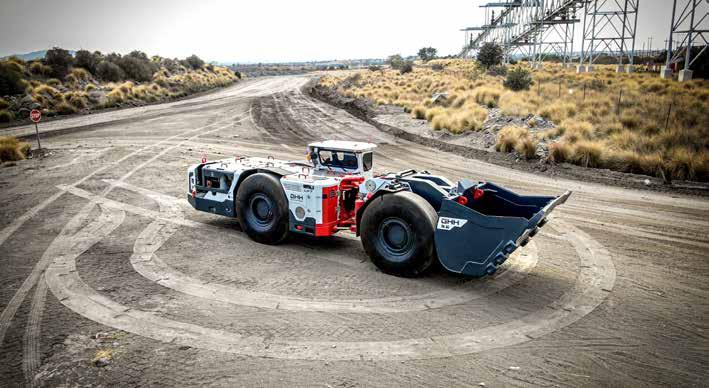
GHH Group, soon to form part of the Komatsu family, has been raising the bar over the last years with significant growth in their product offering to be able to strongly compete in the underground mining space in both hard rock and industrial minerals. With a large product portfolio covering the scope of low profile, narrow vein and mid-seamed mass mining equipment, with loaders from 3 to 21 tons and trucks from 20 to 45 tons, GHH has a very comprehensive range of load and haul equipment.
The LF-10 NEO
One of the Group’s latest releases, the LF-10 NEO, is a powerful 10-ton loader. This loader is not only compact and versatile, with great ground clearance, but also has a high installed power of 240 kW. The LF-10 NEO cabin was designed against stringent ergonomic principles, with its’ large foot box and ergonomic layout of controls supporting high efficiencies in operation, as well as a full air suspension seat ensuring maximum operator comfort leading to excellent productivity, the company said. The modular machine design, including the plug-andplay operators’ cabin, also supports a quicker and easier rebuild process as well as simple and
cost-effective shaft access.
The CE-certified LHD is designed to operate in ambient temperatures of up to 52 degrees and is available in Tier 3, Tier 4 final and Stage 5. With the maximum tipping height in its class, of 2.5m, and excellent reach, the LF-10 NEO is perfect for truck loading all 30-ton trucks in the market, including the new up-and-coming MK-30, 30-ton truck due to launch at the end of 2024.
The MK-30
The MK-30 will boast an extremely ergonomic operators’ compartment with an additional emergency seat when needing to take an additional miner into or out of the operations and an adjustable steering wheel for enhanced operator comfort. The 30-ton truck comes with Tier 3, Tier 4f and Stage V engine packages with 320kWh best-in-class engine power. It should also be noted that the oscillating centre bearing allows for far improved performance enhancing truck manoeuvrability when driving into and out of an incline at an apparent dip and reducing the stresses on the frame significantly. The MK-30 will complement the already well-proven MKA20, a 20-ton truck as well as the MK-45, the largest truck in the offering at 45 tons.
CE Certified LF-3
When it comes to operational flexibility of the GHH narrow vein equipment, GHH also added a “high lift boom” option to the CE Certified LF-3, 3.5-ton narrow vein loader significantly improving the versatility and operational flexibility, especially for truck loading. This loader can operate at altitudes of up to 4000 m. GHH has also taken the next step in globalizing its narrow vein offering ensuring that products like the LF-7 and LF-3 are also now available with Tier 4f and Stage V engine packages including diesel particulate filters, allowing them to be sold into markets that are legislated accordingly.
The LF-19EB: The ‘Green Offering’ GHH is also focused on their “green offering”. The decades of experience in electric loader design, development and manufacturing have provided a strong foundation for this current offering. The LF-19EB, a 19-ton LHD designed, for feeder breaker loading, is a battery electric loader with a 32kWh on-board battery, for easy panel-to-panel movement of around 2.7km, with a tractive effort force of 380kN and an average of 250kVA under permanent load and 315kVA peak and a maximum cable length of 300m. This loader is designed to cater for bad footwall
42 Mining Business Africa |March - April 2024



ROBUST.
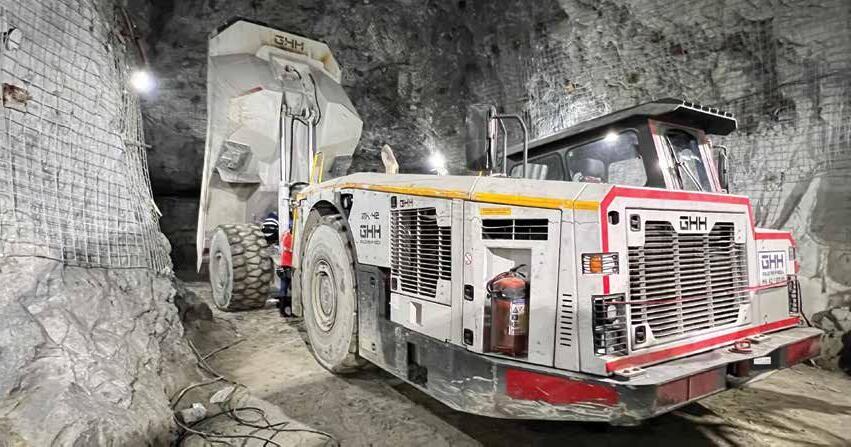
DURABLE. RELIABLE. FOR ALL YOUR MINING NEEDS ...
info@ghhrocks.com www.ghhrocks.com
Loaders and Trucks for Mining Projects

conditions and can operate at a maximum of 28% grade, 15% slope and a maximum of 52° degrees Celsius. The rear of the machine is also ergonomically designed with low and flat top covers to allow for maximum visibility for the operator as well as to be able to negotiate bad undulations in the footwall without hitting the hanging wall with the rear of the machine.
This loader is now being optimized for hard rock applications with the core focus of bringing a carbon-neutral product to market without the difficulties of battery management considerations.
SLP-14E LHD
The new SLP-14E LHD which was launched end of Q1 2023, has a brand new, innovative direct-drive electric drive train that will form the baseline for future developments. Its’ innovative design has significantly fewer components resulting in less maintenance, fewer breakdowns and ultimately reduced maintenance costs and improved availability and potential utilization. And with very little hydraulics, except for the brakes and boom and bucket, the expected reduction in hydraulic-related breakdowns soars even further. The proven vertical coiling cable reel design, with spooling control, which significantly improves the cable life, is standard on this machine. The SLP-14E is not only a technology trendsetter but also provides improved visibility and comfort for the operator, with a brand new ergonomically designed cabin and frame layout. GHH is taking the next steps with this electric drive train and battery electric drive and moving towards full battery drive train designs in the development pipeline.
GHH has one of the largest offering portfolios for the low profile underground mining equipment offering 5, 6 and 8 ton LHDs for hardrock mining and up to 14 tons for softrock mining. GHH can support customers in various low-profile mining
operations with machines for both production and development ends covering stope heights from 1.7 to 2.4m high. The Hardrock offering has variants of air-cooled and water-cooled engine packages to suit various global customer needs, with strong commonality and modularity across the low-profile LHD fleet to be able to support customers with reduced parts holding due to common parts across products.
The SLP-8
In a drive to constantly improve and develop their products, GHH has also worked on enhancing their already well-proven, true 8-ton low profile LHD, the SLP-8, The LHD has recently gone through improvements to enhance performance and assist customers in achieving higher productivity and reduced operating costs like the implementation of a swing cooler for ease of maintenance and reduced downtime and

off the shelf harness availability to also reduce downtime. With the best in class payload, the SLP-8 is tailor-made to be robust, reliable and durable with a long frame lifetime of over 20000 engine hours without issue. The CE Certified SLP-8 has a Deutz TCD 2013 stage 3 engine 179kW with optional DPF available to reduce DPMs and CO2s.
The ROPs/FOPs operator’s compartment is ergonomically designed with optimized visibility, including a camera system for improved visibility if needed and an easy-to-use 7-inch touch screen. The new brake pedal design and aircon blower are just a few of the extras focused on operator safety and comfort. The SLP-8 has best-in-class ground clearance for harsh underground mining conditions, with a cooling system designed for greater than 53 °C ambient and 20.5x25 tyres to negotiate inclined up dip loading, with improved traction and longer tyre life for improved performance and reduced operating costs.
From a safety perspective, the machine comes with accumulator discharge so there is no stored hydraulic pressure on the machine.
The SLP-8 comes with Wi-Fi connectivity, including full machine condition monitoring, bucket weighing for productivity monitoring with bucket tips, electric brake wear sensors and a proven certified controller for underground mining.
Automation
Looking at the road to automation GHH, and their partners NerospecSK and K+S, have recently concluded on-site implementation of a fully autonomous single loader, the SLP-14H, in a room and pillar operation, where the LHD not only avoids recognized obstacles without any further consultation of humans, but it also executes a fully autonomous complex loading strategy, which has not been heard of before.
Other than in narrow vein applications, where positioning of the loader is straightforward, the attack strategy in broader room and pillar applications is critical to achieving a complete and efficient loading cycle, which the developed system does. After successful mucking, the loader will navigate to the dumping location and approach it without the use of any optical technology, which is susceptible to dust. Once dumping is completed the machine will continue the work cycle and return to the mucking location or switch to the next location, depending on what work sequence has been given by the leaving shift team.
Automation-ready, PDS level 9 interface
All the GHH loader and truck ranges are available with PDS level 9 interface as well as automation ready and available with GHH inSiTE, our digital analytics solution, which can be customized to support specific customer and application needs.
44 Mining Business Africa |March - April 2024
Cable Vulcanizers for mining
Highest demand for IMS Engineering’s Cable Vulcanizer in mining
The mining industry presents the greatest demand for the significant cost- and timesaving Cable Vulcanizer from Gauteng stainless steel and steel products manufacturer IMS Engineering.
When using electrical cabling, damage is unavoidable, says the broad-based black economic-empowerment Level 2 company.
Established in 2005, IMS Engineering developed the product to meet the need for a cost-effective, locally produced alternative to expensive imports, as well as to promote job creation.
Exported throughout Africa and to Australia, the demand for the Cable Vulcanizer is driven by the need to improve the ease of replacing and repairing electrical cables on site and eliminating the need to replace an entire cable drum, says Impact Measurement Solutions technical marketing director, Ken Falconer.
Not only does the product decrease cable wastage, as short lengths can be joined to new cable lengths, but it also helps limit downtime to improve productivity and, thereby, the profitability of an operation.
IMS Engineering recently delivered two Cable Vulcanizers each to two African customers, one of which is a South African mining operation. The orders comprised electrical controllers, moulds, vulcanising kits, tape and operating and instruction manuals to facilitate the repair and joining of damaged electrical cables on site.
The 220 V, 3 000 W Cable Vulcanizer comprises 165 x 510 platens, a 400 x 510 work bench, a 150 C set temperature, temperature adjustable up to 120 C/175 C, an Acme screw with a 38 mm thread, a 150 mm standard throat opening and a 250 mm high back throat opening.
The vulcanizer is equipped with moulds


manufactured to cable size, is easy to load and unload, offers sturdy construction to withstand harsh industrial and mining environments, has easy open front access and a snap-on temperature probe with an easy-to-read temperature output.
“Our steel frame Cable Vulcanizer is favoured inside many repair shops. With our sturdy steel frame unit weighing in at 70 kg, it is a portable and mobile unit. We also offer a light aluminium frame model that allows for easy transportation and remote setup,” says Falconer.
The Cable Vulcanizer is manufactured at the company’s Alberton factory, with the production rate dependent on demand.
All IMS Engineering Cable Vulcanizers can be custom designed to customer specifications, as “we are often requested to customise units depending on customer’s specifications and needs”, explains Falconer.
Launched four years ago, the product comprises 100% local content, with no imported materials or components used in its design, he adds.
“The use of locally sourced components and materials is very important for manufacturing and turnaround time when servicing and replacing broken parts or for modification.”
The company has continued to make improvements to its Cable Vulcanizer over the last two years but has found the cost of material to be most challenging in this regard. This has further promoted the use of locally sourced materials to prevent production of the Cable Vulcanizer becoming too costly, concludes Falconer.
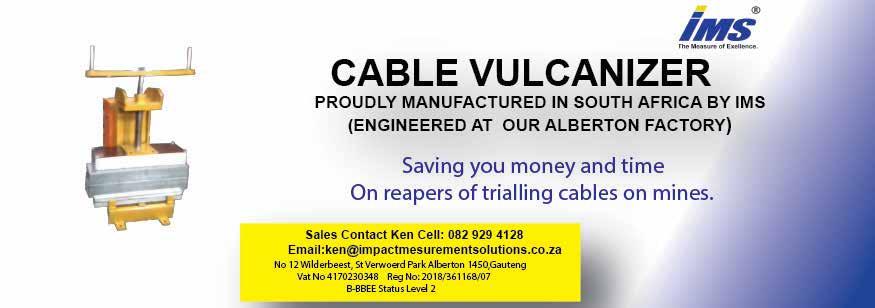
Mining Business Africa | March - April 2024 45
The steel frame Cable Vulcanizer is favoured inside many repair shops.
Suto Instrumentation and Sahara Air Dryers
Artic Driers has over 30 years in the air treatment business.

Compressed air quality is an issue in most organisations, and in many cases, it’s a neglected topic. Contaminated compressed air (C/air) is as bad as no compressed air!
Solutions
Two products offer solutions to these air quality problems, the SAHARA range of low dewpoint heatless pressure swing air dryers and the SUTO iTEC compressed air instrumentation.
SAHARA SERIES AIR DRYERS
– Artic Driers manufactures the range of Sahara low dewpoint Heatless Pressure Swing Air Dryers
at their base in Johannesburg to SANS 347 codes. Designed to be desiccant-rich, pressure dewpoints of minus 40°C are standard.
The build standard & specifications are to a high standard. Smaller dryers are free-standing, whilst bigger capacity dryers are fabricated on a heavy-duty baseplate.
All the dryers are designed to be transported in a standard container, making it ideal for shipping into Africa. If required, pre & after filters may be fitted to the dryer’s baseplate prior to despatch.
The Sahara units all use the Artic RSA patented shuttle valve & orifice plate holder. The Shuttle comprises only 4 items and provides the
highest reliability in a wide range of service/site conditions.
The standard Sahara dryer has only two pneumatically operated dump valves. This reduces the maintenance requirement and makes any fault finding a breeze.
If needed, the dryer’s control timers can be adjusted on-site. Sahara dryers may be equipped with an optional dewpoint control, as well as pressure & flow monitoring. Dewpoint control reduces the c/air purge requirements and extends the cycle times of the dryer. On larger air dryers all the electrics are housed in an IP65 cabinet.
Power Outages creating re-start problems - Sahara dryers re-start automatically on the resumption of power.
Huge range of ex-stock filter casings
- Artic Driers provides a huge range of imported & locally produced air filter housings that can hold different grades of filter elements to suit any client’s requirements. Locally produced filter casings are SANS pressure-coded & are coated to resist interior & exterior corrosion. All the element fixings are s/steel. Artic carry stock with capacities up to 150 m³/min.
If you need a tough versatile filter dryer package for your plant, call us now.
Need to know more about your compressed air consumption?
A broad range of instrumentation focused on compressed air & gas monitoring for volume, pressure, power consumption and c/air quality is available from SUTO iTEC & Artic Driers
Flow monitoring equipment is suitable for pipelines from 15 mm to > 400 mm and compatible with most gases with pressures from vacuum to over 40 bar G.
Adding an S331 data logger can provide plant operators and managers instant access to all the parameters, flow, pressure, dew point, temperature, power consumption, oil vapour content as well as particle content.
When coupled to the local data network it will transfer all the information to the central management system in the plant. Data transfer from the S331 data logger to a USB stick is also provided.
These SUTO iTEC products give an instant
46 Mining Business Africa |March - April 2024 Heatless Pressure Swing Air dryers & Compressed Air Instrumentation
overview of your plant’s consumption and quality parameters, making benchmarking consumption & c/air quality simple.
Air leaks causing production cost issues? Artic Driers International, SUTO iTEC’s Southern Africa partner, offers an Ultrasonic leak detection solution. The reporting software provides immediate information on the cost of c/air wastage, and the the volume of air being wasted to the atmosphere. Results are provided in PDF & Excel (csv) format which allows you to plan your rectification programs. Artic offers this equipment for sale, or hire with one of our technicians.
Compressed air quality a problem?
The SUTO iTEC S600 certified mobile Air Quality System has the solution measuring dew point, airborne particle sizes as well as oil vapour carry-over. It automatically creates a PDF report that rates your test results against the ISO standard without any input requirements from an operator. Air quality reports are generated before Artic leaves your site. This is exceptionally useful for QA & facility managers alike.
Leaders in the air treatment business for over 30 years, Artic Driers has an exceptional range of equipment, along with in-house manufacturing capabilities. This makes Artic Driers a “Preferred Supplier” to solve your compressed air problems. With a large warehouse inventory, we rarely disappoint.



Call us now with your requirements on 011 420 0274 and speak to our sales team for more information. International (Pty) Ltd

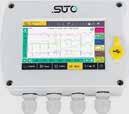
Mining Business Africa | March - April 2024 47
TM
Resources 4 Africa is pleased to announce the 10th edition of its annual Junior Indaba, a popular meeting place for junior miners which is enjoyed by all for its incisive, informative and frank discussions tackling the challenges and opportunities for exploration and junior mining companies in South Africa and elsewhere in Africa. This year discussions will focus on the role of juniors in meeting the demand for critical metals, the global outlook for commodities, investors’ perspectives on junior mining projects, ESG considerations and more. We will feature a number of junior mining success stories, as well as our regular features - Myth Busters and a showcase of presentations from junior miners across the continent.
Premium Sponsors: Lead Sponsor:
Mining Industry Partners:

Networking Sponsors: M&D




Business Africa (MBA) is Pan-African bi-monthly publication that focuses on latest developments in mining and allied industries in Africa. The publication covers the scope of critical activities from pit to port – mineral exploration (prospecting), mine planning and development, extraction, mineral processing, storage transportation, as well as beneficiation. Mining Business Africa provides the desired mileage for companies looking to promote their products and services to a specific niche clientele in the African Mining Sector. Subscribers are located or at least involved in projects in South Africa, Botswana, Zimbabwe, Zambia, Kenya, Democratic Republic of Congo, Kenya, Tanzania, Ghana and Nigeria.
MBA is published by Media Icon, a company manned by personnel with a combined experience of 30 years in the publishing space.
Advertiser’s index AME trade................................................................................05 Artic Driers International Pty Ltd..........................................47 Bruker........................................................................................11 Enlit Africa...........................................................................OBC Evra Consulting......................................................................03 Flyability SA............................................................................31 GHH Group GmbH................................................................43 Impact Measurement Solutions Pty Ltd..............................45 Industrial Valves Summit Italy- (IVS).................................IBC Invincible Valves................................................................14/22 KSB Pumps and Valves Pty Ltd............................................15 ME Elecmetal...........................................................................18 Mineware Consulting.............................................................39 Mixtelematics..........................................................................24 Munters pty Ltd.....................................................................IFC Onyen......................................................................................28 Poynting Antennas.................................................................37 Resources 4 Africa................................................................48 Sitech SA................................................................................21 WearCheck Africa..................................................................35
Mining
TO ADVERTISE | CALL: + 27 10 055 3356 | Email: info@miningbusinessafrica.co.za
- 22 MAY 2024 www.juniorindaba.com The Country Club Johannesburg, Auckland Park & Online 10TH ANNUAL EDITION FOR EXPLORERS, DEVELOPERS & INVESTORS IN JUNIOR MINING
of the
21
Contact us about sponsorship opportunities: sponsorship@resources4africa.com Tel: +27 (0) 11 463 7799 // +27 (0) 61 421 9492 // registrations@resources4africa.com The 2024 Junior Indaba is brought to you by Resources 4 Africa, the organisers
Joburg Indaba.





FOR SPEAKER OR SPONSOR OPPORTUNITIES, CONTACT INFO@ENLIT-AFRICA.COM | +27 21 700 3500 CPD Accredited by Created by Host city Host utility Host ministry EnlitAfrica Enlit-Africa enlitafrica @Enlit_Africa SCAN HERE TO REGISTER AFRICA IS READY FOR THE ENERGY TRANSITION REGISTER FOR ENLIT AFRICA: Africa’s end-to-end power, energy and water conference & expo 21 - 23 MAY 2024 CTICC, CAPE TOWN, SOUTH AFRICA www.enlit-africa.com












 By Jimmy Swira
By Jimmy Swira


































































































